|
A Timeline of Major Events during this period
1602 The Dutch East Indies Company (VOC) is chartered ... eventually taking on Portuguese
competitors ... and Portuguese strategic positions along the East-West
trade route
1603 Pro-Protestant James I Stuart becomes King of England (already king of Scotland)
1607 The English establish the Virginia colony at Jamestown
1608 Champlain establishes a French settlement at Quebec
Deeply persecuted Protestant Separatists, under John Robinson, leave
England for the
fellow-Protestant Netherlands
1609 The Dutch hire English seaman Henry Hudson to explore a path to the East via a river
route across North America ... ultimately discovering the "North" or
Hudson River
Johannes Kepler publishes his Astronomia nova ... broadening considerably the realm
of modern astronomy ... seeing a Godly order in all of creation
1610 "Good King" Henry VI is assassinated by a Dominican monk; his very young son (only 9)
becomes French king as Louis VIII ... his mother Marie de Medici in
fact ruling France
1611 Protestant king Gustavus Adolphus (1611-1632) turns Sweden into a great military power
1615 The papal Inquisition deems Galileo's heliocentrism (sun, not earth, as center of the
universe) to be contradictory to Biblical standards
1617 Louis XIII finally takes control of France ... Cardinal-Duke Richelieu being his key advisor
1618 The Thirty Years' War (1618-1648) breaks out, involving Europe's continental powers
in periods of intense conflict over religion and political jurisdiction
1619 Slaves are brought to Virginia to work the tobacco fields
1620 Sir Francis Bacon's Novum Organum employs an empirical approach to social study
Some of Robinsons' Separatists leave Europe to find refuge as "Pilgrims" in America
1621 The Pilgrims establish a Plymouth plantation or colony at Massachusetts' Cape Cod
Philip IV of Spain (1621-1665) becomes king of a fast-declining Spain ... the decline
due in part to the huge expenses involved in fighting the Thirty Years'
War
The Dutch establish the Dutch West India Company (GWC) to explore and
settle the
North American coastal region ("New Netherland") lying between the
"North" (Hudson) and the "South" (Delaware) Rivers
1622 Count-Duke Olivares becomes Philip IV's Valido or counsellor (1622-1643) ... who pushes
Philip to involve himself exhaustingly in the various wars of the day
1625 James I dies; his pro-Catholic son Charles I becomes English-Scottish king (1625-1649)
He will at first (1625-1633) try to rule without Parliament
Hugo Grotius attempts, with his On the Law of War and Peace, to apply legal reasoning
as the path to peace ... greatly needed during the Thirty Year's War
1628 The Protestant fortress at La Rochelle is finally brought down ... completing Louis and
Richelieu's program of ending all local Huguenot authority in France
1630 Under John Winthrop's leadership, a flood of Puritans to England starts (1630-1642) ... some 20,000 of them
1632 Galileo's Dialogue Concerning the Two Chief World Systems defends his heleocentrism ... and ridicules the papal and Jesuit position on the subject
1633 Charles I appoints conservative William Laud as Archbishop of Canterbury ... who will
use the Star Chamber to persecute Puritan opponents
1636 Roger Williams is "invited" to establish his own "pure" colony at Providence
1637 René Descartes tries to lay mathematical foundations to all truths, social as well as physical in his Discourse on Method
1638 An argumentative Anne Hutchinson is forced to leave the Massachusetts colony
1640 Archbishop Laud is arrested by British Parliament
1642 Full civil war between Charles I and Parliament breaks out (1642-1649)
This restricts greatly the flow of Puritans to New England
1643 Philip's Spanish army suffers a huge defeat by the French at the Battle of Rocroi
But Louis XIII dies a few days earlier, leaving the throne to his son
(only 4!) Louis XIV
1644 Oliver Cromwell heads the Puritan Parliamentary army
1645 Archbishop Laud is executed on Parliament's orders (Jan)
Charles I's army is defeated by Parliament's heavily Puritan New Model
Army (Jun)
Charles escapes to Scotland, but (under payment) is sent back to England
1648 The Treaty of Westphalia finally ends the European Wars of Religion (Thirty Year's War) ... all signatories agreeing to let their own authorities determine
their society's religion
In
the East, a Ukranian uprising against Polish authority begins the
"Deluge" ... the
beginning of the destruction of the huge Polish-Lithuanian Commonwealth
1649 Charles I is beheaded; his son Charles II escapes to France
Parliament establishes the Puritan Commonwealth ... under Cromwell's
command
|
The Wars of Religion
It is usual to caption the first half of the 1600s as the time of an
almost endless series of “Wars of Religion.” Indeed, religion
played a part ... though it was not really religion that caused these
wars. Religion only justified these wars. What this
tumultuous period was all about was the realignment of political power
caused by the collapse of Christendom. The old moral order
overseen by the Pope and Holy Roman Emperor had definitely disappeared
... and there was a scramble of rising political figures bent on
securing for themselves a stronger position in the emerging status
quo. This really was therefore a war of rising states, both
monarchical (kings) and commercial (city-states). With the
collapse of old Christendom, there were no rules in the struggle and so
it became an all-out war of player against player. Therefore the
period properly ought to be termed the “War of the Post-Christendom
States”!
The Thirty Years' War
It
is also termed the period of the "Thirty-Years' War." Actually
wars among the rising European states had been going on rather
constantly over the previous century, though they tended to reach a
particularly devastating proportion in the period 1618 to 1648.
And the exhaustion experienced by all the players in this struggle
finally brought something of a more enduring truce (though by no means
end) to the inter-state conflicts. Indeed, it seemed to mark the
beginning of a new era in European politics (and European history).
The Treaty of Westphalia (1648) and the dawn of a new era
The peace treaty of 1648 would end up not being just another one of the
many truces that had provided only a temporary pause in the
fights. Westphalia marked a deep resolve among the contenders to
accept things as they had come to be politically by 1648 ... and to
turn to something other than religion on which to guide their political
ideals and justify their ambitions. Thus it was that
non-religious or secular science would begin to take the place of
Christian theology as the new world-view undergirding the new thoughts
and dreams of political philosophers and political activists appearing
at the end of this period of war.
Indeed, at this point Christianity itself would enter into a time of
deep contempt by the more "enlightened" Europeans ... who were certain
that they were on the path of discovery of something much higher, more
noble than the worn-out moral-spiritual standards of Christianity.
Spanish power begins to slip
The wars had been costly to all of the dynastic and urban contenders,
but to Spain most of all. In all the years of Spain's great
wealth in American plunder, Spain had never put that wealth to work,
but had merely consumed it as it rolled in across the Atlantic ...
squandering that wealth in a grand display of status-enhancing material
splendor – and in a constant round of wars with other European
powers. The latter had proven costly to Spain, especially
the ones waged against both the rebellious Dutch and the piratical
English.
The drying up of the American plunder in gold
Everything
about the Spanish economy depended on the continuous flow of American
wealth. But the plunder would run out as the Spanish stripped the
Indian societies of their stock in gold. Confiscated silver would
soon be substituted ... and then slavery of the Indian population to
force them to continue to dig the precious metal from the ground – in
order to feed the material appetite of Spain. But this substitute
of silver would not permit Spain to continue to live at the material
level it had grown accustomed to when it was living on plundered
gold. The silver mines would not suffice to pay the mercenary
armies fighting the king's wars, the navy needed to protect this flow
of wealth from the Americas, and the thousands of government officials
and noble families dependent on this flow. Thus Spain would
decline ... inevitably.
Mediocre kings and royal advisors
Besides
the all-important factor of the gold flow to Spain slowing up as key to
a relentless decline that set in upon Spain in the 1600s, was that this
this process was greatly accelerated by the line of mediocre
Habsburg kings (and their advisers) who followed Charles and Philip in
the 1600s: Philip III (King of Spain, 1598 to 1621)
and his son Philip IV (King of Spain, 1621 to 1665). They were
not bad kings ... just not the caliber of leaders needed by a great
society to hold on to that greatness ... a problem common to all great
societies in decline. Both kings depended on their chief
ministers, the Duke of Lerma under Philip III and the Count-Duke
Olivares under Philip IV. Further, Philip IV was burdened
financially by the costliness of the wars on land and sea that were a
central piece in the 30 Years' War. The English and French had
allied against Habsburg Spanish power – a challenge that Philip knew he
had to answer. Under Olivares's advisement, Philip attempted to
reform Spanish government to make it more efficient so that he could
cover the costs of war (the flow of American gold and silver having
slowed up) ... but in the process only alienated the traditional
Castilian aristocracy that had been the bedrock of royal power.
Then he began to lose further control of the political situation when
in 1640 first the Catalans, supported by the French, revolted – soon
followed by the Portuguese (who sixty years earlier had been brought
into the Spanish Habsburg realm) who did likewise. Compromise
(and removing Olivares) would eventually bring some of the crisis under
control – though from 1640 on, Portugal would remain independent under
the new Braganza dynasty.
The Battle of Rocroi
But the biggest blow came in 1643 when Philip's army was sent south
from the Spanish Netherlands (Belgium) to attack France in order to
divert the French from their support of the Catalan revolt. But
the tactic turned out to be a disaster for the Spanish. It was
the first major defeat of the Spanish army since Spain's rise to power
in the 1500s (Spain's navy, of course, had already suffered its own
setback in 1588) – and clearly signaled a huge slippage of Spain as the
leading power of continental Europe. France would soon be
occupying that prestigious position.
|
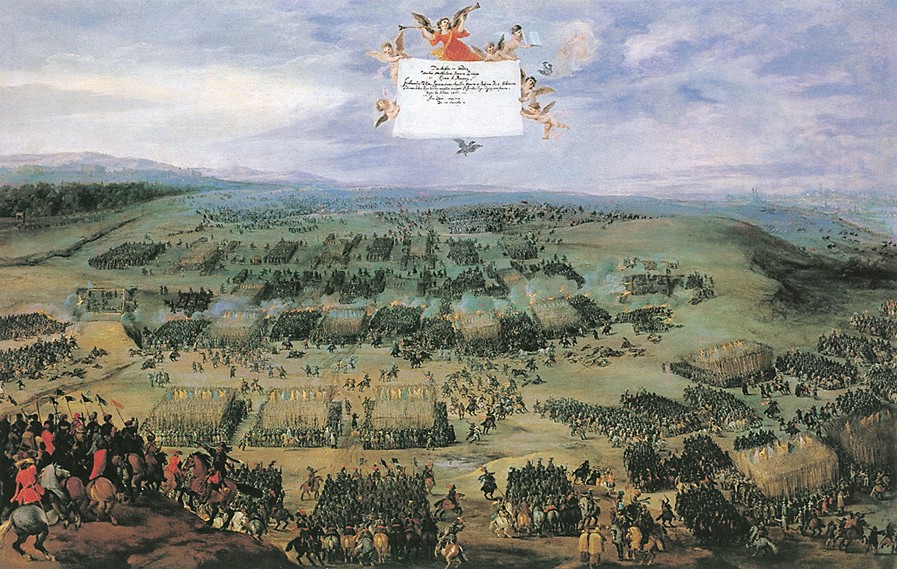
The Battle of White Mountain (1620)
in which the armies of the Habsburg Emperor Ferdinand II – in alliance with the forces of the
Catholic League – defeated the Bohemian (Czech) forces ... ending Bohemian independence
and beginning the forced return of Bohemia from Protestantism (Calvinism mostly)
back into Catholicism.
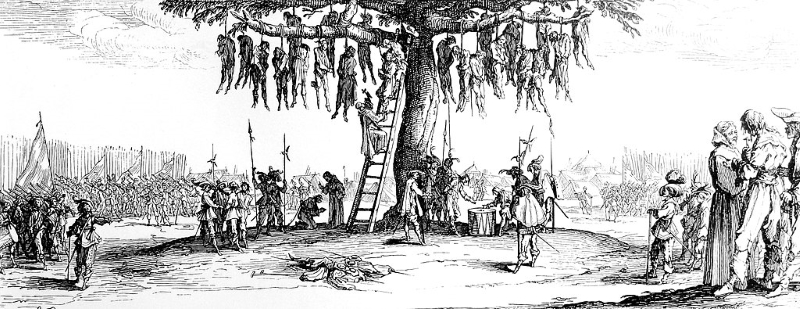
The Great Miseries of War - by Jacques Callot (1632)
Cambridge University
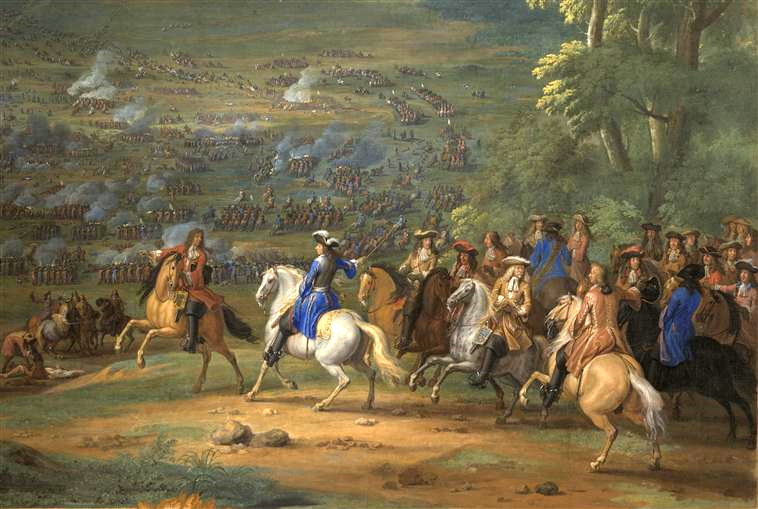
The Battle of Rocroi (1643) - by Sauveru Le Conte
France although officially a Catholic country – opposed Catholic Spain after its many
victories against Europe's Protestant armies ... and met and soundly defeated the
supposedly unstoppable Spanish ... marking the rise to dominance of France
in European continental affairs - and Spain's rapid decline in importance
Musée Condé de Chantilly
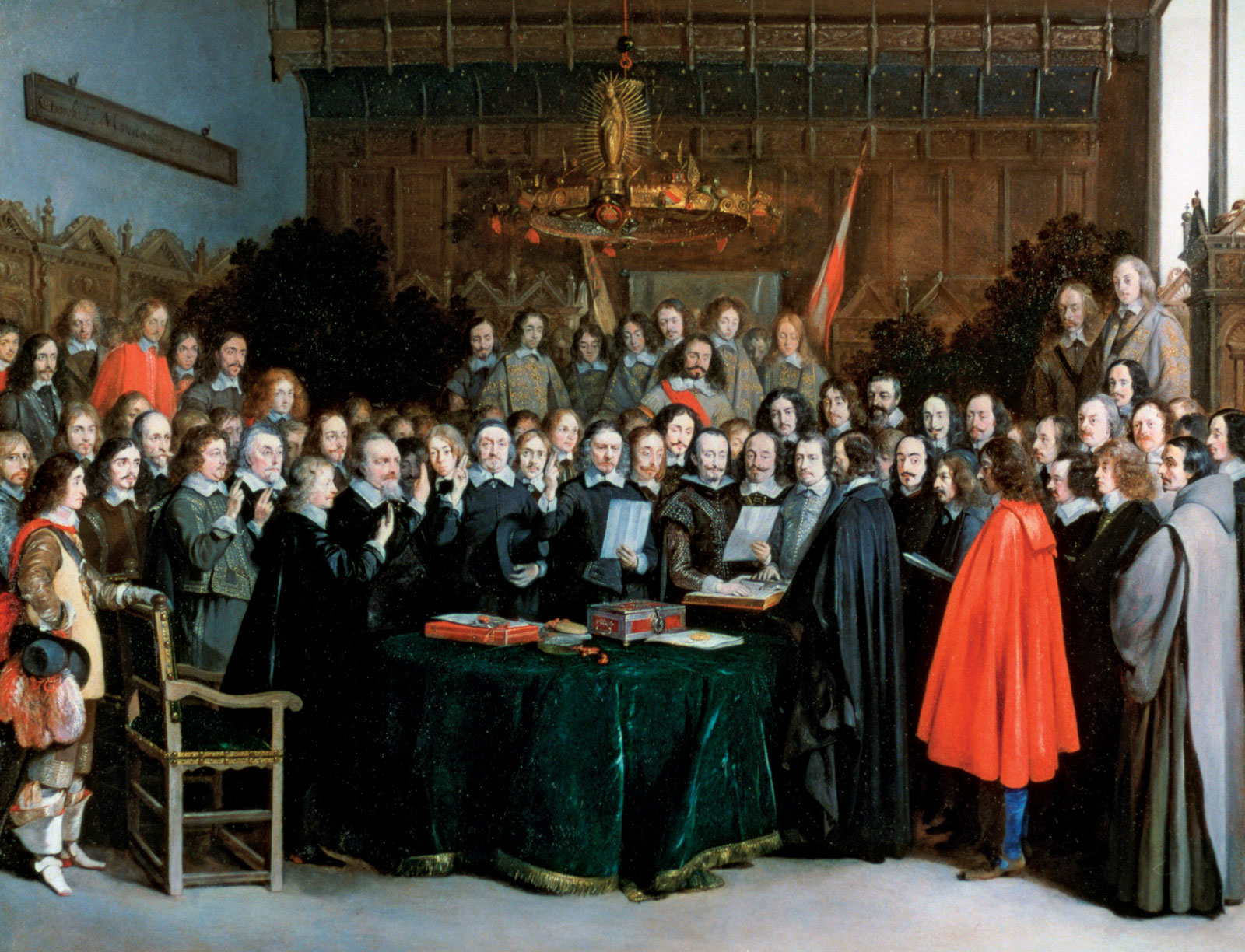
European dignitaries offering an oath in support of the "Peace of Westphalia" - 1648
The Swiss and Dutch now recognized as independent societies; Protestant German states
are recognized as independent: Sweden and France gained territory
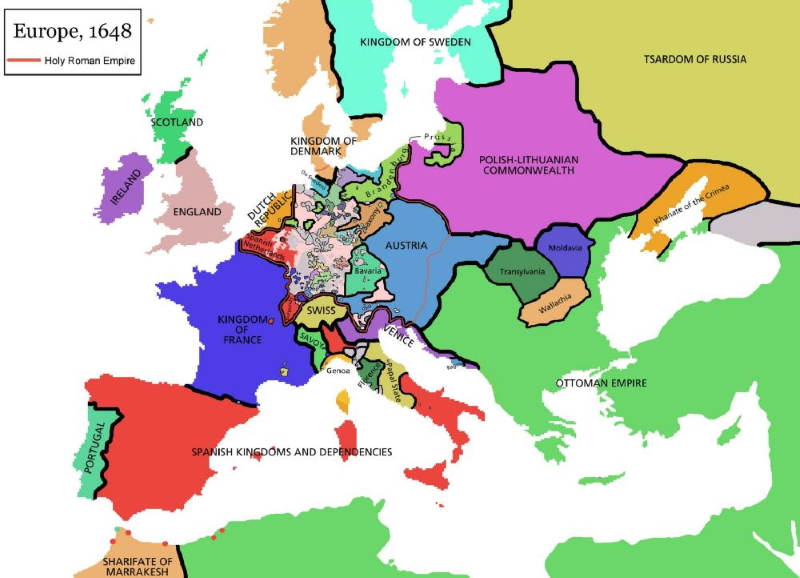
Europe in 1648 - at the time
of the Treaty of Westphalia
|
Against the French nobility
Louis had other problems at home (besides his mother and his rebellious
younger brother Gaston!): the independent-minded French nobility and
the Protestant Huguenots. Richelieu convinced Louis to order the
destruction of all the castles of the nobility, sparing only those of
clear strategic worth to the monarchy. This not only deprived the
nobility of their prestige, but also of their real power. It was
the beginning of the French monarchy as a Absolutist institution (all
power to the king ... and to him alone!). Thus he was widely
hated by the French nobility. But Richelieu was not one to be
contended with.
Against the Protestant Huguenots
Richelieu also stood at the center of the decision to bring to an end
the power and influence of the French Protestant Huguenots. Early
efforts at seizing their various strongholds located around France
(mostly in the South) met with mixed results. Finally in 1628 the
major Huguenot fortress of La Rochelle was overrun by Louis's army ...
led personally by Richelieu. The defeated Huguenots however were
still permitted to practice their religion as per Henry IV's Edict of
Nantes (which had promised certain religious freedoms to the
Huguenots). But in losing La Rochelle, the Huguenots no longer
had any muscle of their own to protect themselves against any further
attacks on their religious freedoms in France.
In the New World (New France)
Since the early 1500s France had been involved in exploring the lands
to the north of the Spanish Habsburg holdings in Central and South
America. Francis I had sent (1520s) first the Florentine
navigator Verrazzano to explore these coastal regions (the first
European to discover what is today New York) then Cartier (1530s) to
explore even further north along the St. Lawrence River (which they
hoped was a river route which would cross the Americas and permit them
to continue to sail West to Asia) laying claim to New France in the
process. But French settlements there at first failed to take
hold. Later (1564) Huguenots escaping troubles in France settled
in the area of what is today northern Florida (Jacksonville) – though
the Spanish quickly reacted and sacked the French settlement
there. Not until the early 1600s would the French under Champlain
try again to establish settlements in the New World ... at Quebec
(1608) on commanding heights above the St. Lawrence River and here and
there along the islands lying to the South of the entrance to the River
... what would eventually become French Acadia. French settlers
were encouraged to befriend the Indians ... whom the French considered
as fully French in accepting Catholicism and learning the French
language. French fur hunters and traders took Indian wives and
soon informally extended French influence deep into Canada.
But until Richelieu took a strong interest in the American project,
French settlement itself remained thin ... particularly in comparison
to New England, just to the south of New France (where by 1630
thousands of English were beginning to settle). Huguenots were
not permitted to settle in New France ... and thus just as New England
was devoutly Protestant, New France by careful design was devoutly
Catholic. Extending feudal rights to French lords or seigneurs
willing to organize and oversee communities of settlers, New France
finally began to grow (only in the second half of the 1600s however ...
and slowly at that).
Against Spain
A
continuous problem, inherited from Louis's predecessors, was Habsburg
Spain. Despite efforts to forge a friendship with Spain through
marriage (Louis was married to Anne of Austria, daughter of Philip III
of Spain), and despite both kingdoms being staunchly Catholic, the
Spanish and French kings (Louis and Philip IV) were natural contenders
for dominance in continental Europe ... especially as Spanish holdings
surrounded French holdings on virtually every front: Spain itself,
Belgium, Luxembourg, Western Germany, and Northern Italy. Thus it
was that the Catholic Cardinal Richelieu advised Louis to ally with the
Protestant Netherlands in the on-going Spanish-Dutch war which raged
during the Thirty-Years' War. But similarly, Catholic Spain sent
aid to the rebellious French Huguenots to keep Louis occupied at home
in France while the Spanish strengthened their position in Northern
Italy!
Louis did not live long enough to see the massive French victory over
the Spanish at Rocroi in 1643 (he died in Paris of tuberculosis just
days before the battle). But he left to his 4-year-old son Louis
XIV a monarchy well on the way to being the major player in the
European dynastic game.
1She
had a reputation as a schemer. It was believed by many at
the time (and by some still today) that she was somehow involved in
Henry IV's death.
THE ONSET OF THE DUTCH "GOLDEN AGE" |
|
Cruel adversity toughens the Dutch spirit
The Dutch North or Netherlands, though tiny in size on the European
map, had turned itself into a powerful commercial center ... complete
with vast commercial empire, soon reaching around the world.
Cruel adversity had steeled the wills of the Dutch and, along with
their work ethic, had transformed them into the most industrial-minded
people of Europe. They were very creative in their
industriousness, setting up in Amsterdam the first multinational bank,
doing business with interested investors across all sorts of political
boundaries. Also at Amsterdam the first stock exchange was
established, where investors (or "adventurers') could put their money
in a new enterprise ... with the hope of making a huge profit when the
enterprise met its industrial or commercial goal. Of course there
were risks of failure. But the strong-willed Dutch were willing
to take those risks.
Dutch commercial expansion
While
they made much of their money in manufacture, the greatest portion came
through commerce or trade. The Dutch were superior tradesmen,
purchasing the goods of distant lands and returning those goods by sea
to Europe ... making huge profits in the process. They thus
developed a vast merchant fleet (the Dutch possessed more merchant
ships than all other European powers combined) protected by a very able
navy. They quickly outpaced the Portuguese in terms of their
commercial reach. Indeed, the Dutch East Indies Company soon
became the largest commercial enterprise connecting Europe with Asia.
The Dutch-Portuguese War (1598-1663)
This process of Dutch expansion – largely at the cost of the Portuguese
– did not happen overnight, but took decades to achieve. The
contest between these two commercial empires was global, from the
Americas in the West to the Indies in the East ... though the East
Indies portion of the war would prove to be the more important
engagement of the Dutch. Success in overrunning most of the
Portuguese positions there turned out to be very profitable for the
Dutch ... as the demand for the spices nutmeg, mace and cloves found in
the Spice Islands was running very high at the time.
Dutch South Africa
Although the Dutch did not succeed in displacing the Portuguese in
coastal southern Africa, when it came to the vital position at
Africa's southern-most tip at the Cape of Good Hope, the Dutch were
most focused. From that strategic point they could then proceed
directly east to the Spice Islands of the East Indies. But they
secured the area not only militarily, but also demographically ...
establishing a large Dutch settlement at what would come to be known as
Cape Town.
Local resistance from the native African population was rather
light. The San (Bushmen or Hottentots) were a very primitive
hunting society, thinly spread across the region. The more
dangerous Bantu African tribesmen had not yet reached the area in their
own expansion southward along the East African coast. In
fact, both groups, Dutch White and Bantu Black were very surprised to
run into each other a century later (1779) when the two
groups, the Dutch spreading northeastward and the Bantu (Xhosa
tribesmen) spreading southwestward, met at the Great Fish River (about
halfway across today's South Africa).
In short, the Dutch were doing in South Africa what the English were
doing at that same time in North America: extending their
population deeply into overseas lands. And – just as the English
of America were beginning to identify themselves primarily as
"Americans" – so too the Dutch of South Africa were calling themselves
"Afrikaners"! And like the English-American frontiersmen who were
largely self-sufficient Protestant farmers, so too were the Afrikaners
– identifying themselves as such also with the name "Boer" (Dutch
simply for "farmer) – and quite proud of that identity ... as these
Boer families spread themselves ever-deeper into the South African
interior.
Dutch America
Also, like the Spanish, Portuguese and French (and soon the English)
the Dutch, through their West Indies Company, got deeply involved in
opening up commerce and settlement across the Atlantic in the
Americas. They established a "New Netherlands" in the middle
reaches of North America, ranging from what is today Connecticut in the
north to Delaware in the South – with New Amsterdam (today's New York
City) as its capital. They particularly focused on the "North
River" (Hudson River) ... hoping it was the waterway that led across
the American continent to the Pacific. Eventually finding this
hope groundless, they nonetheless placed Dutch forts and numerous Dutch
settlers along the fertile shoreline of this mighty river, and opened
up trade in furs with the Indians. Here too, the Dutch population
began to grow.
Dutch independence
Meanwhile, the Habsburg Spanish were refusing to give up in their
effort to retake their ancestral northern Dutch or Habsburg lands ...
as they had so successfully retaken the southern Dutch lands (Flemish
lands actually). But besides the fact that the entrepreneurial
Dutch were quite capable at self-defense, both the English and the
French tended to ally with the Dutch against powerful Habsburg
Spain. Finally, in 1648 the Spanish had had enough of the effort
and in the Treaty of Westphalia acknowledged the independence of the
Dutch Republic.
The highly sophisticated Dutch culture
But the Dutch were not just about business. Art and architecture
flourished, with Dutch artists being some of Europe's finest (Rembrandt
and Vermeer, for instance ... among many others). Education and
science took a huge lead in the Netherlands, with the establishment of
a number of outstanding universities ... and excellent
scholarship. The practical Dutch were fascinated by the physical
world around them and studied it closely, Huygens and Leuwenhoek being
among the leading scientists of their times. But the Dutch could
also lead in the world of scholarly philosophy, Spinoza – a Dutch
Jew of Amsterdam – being an example. So free (relatively speaking
anyway) was the academic atmosphere for study and writing that other
Europeans relocated there ... such as the famous French philosopher
Descartes (from 1628 to just before his death in 1650). |
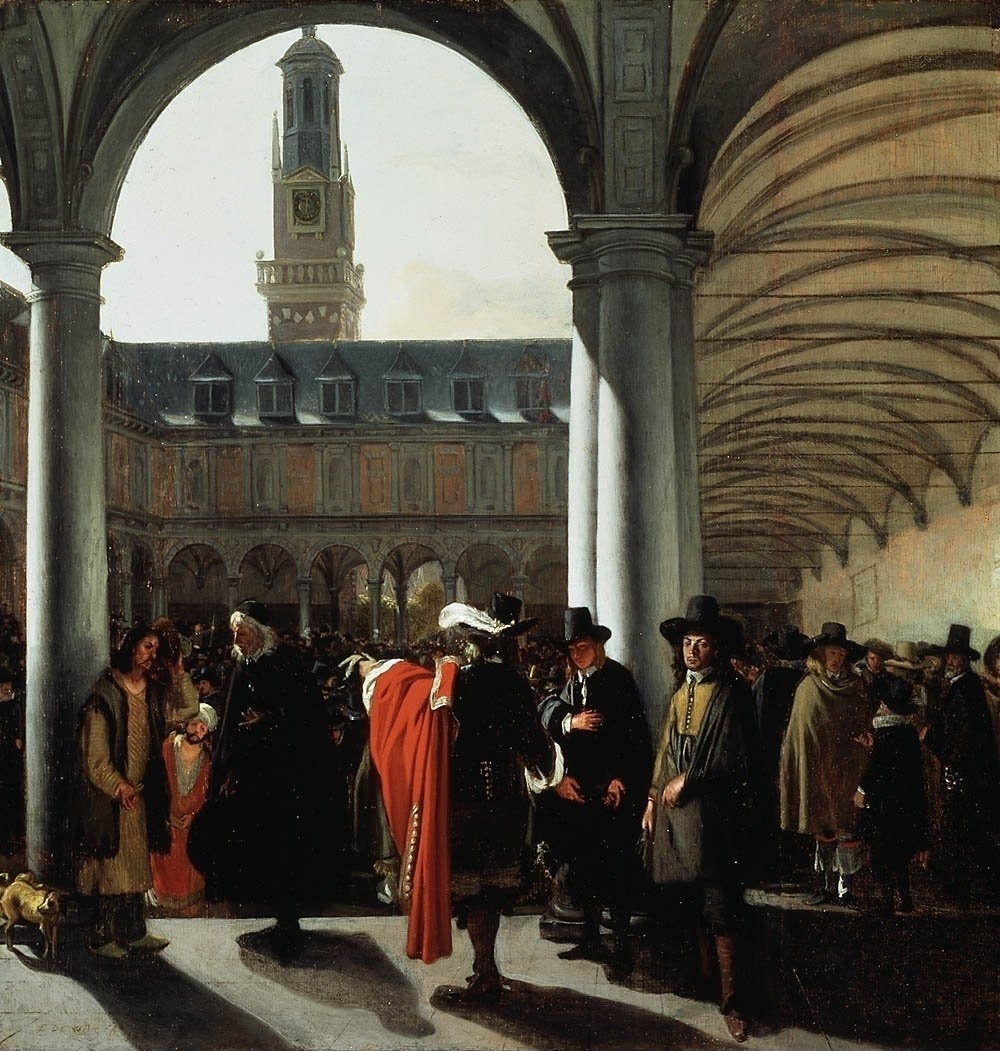
The Courtyard of the Exchange at Amsterdam

Dutch East Indies capital at Batavia (Dutch Indonesia)
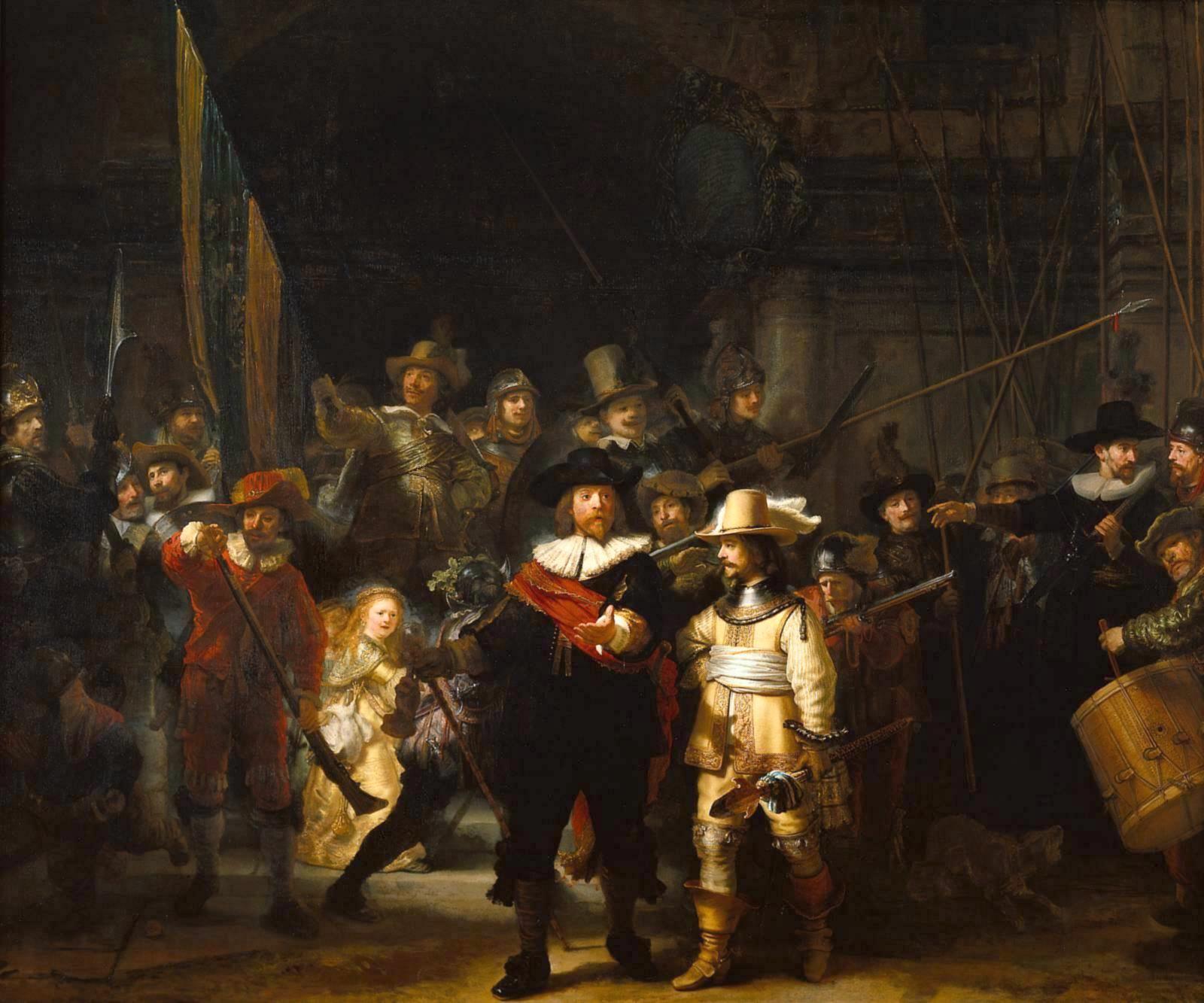
Rembrandt van Rijn – The Night Watch (1642)
Amsterdam Museum
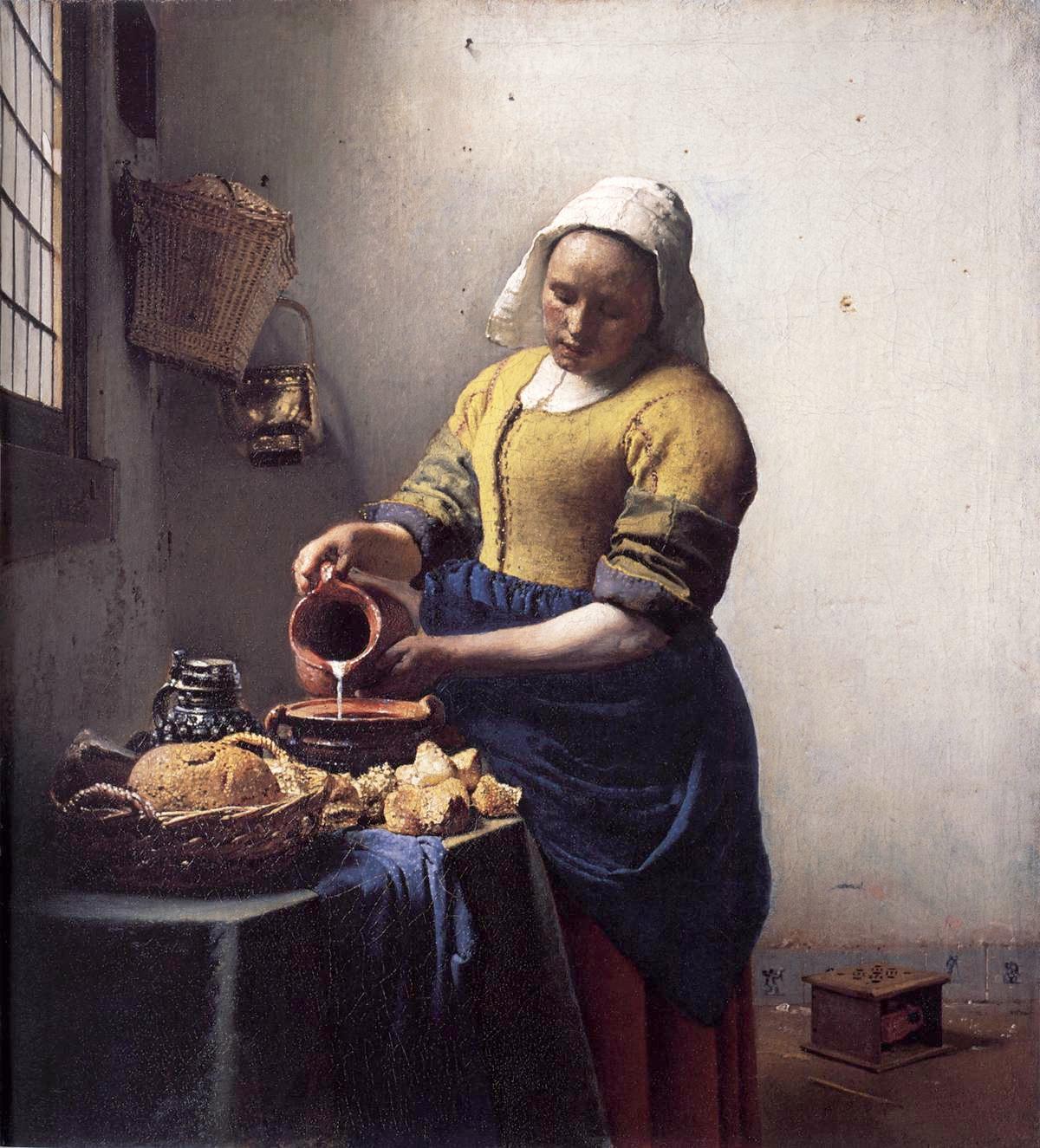
Jan (or Johannes) Vermeer – The Milkmaid (1658)
Rijksmuseum - Amsterdam
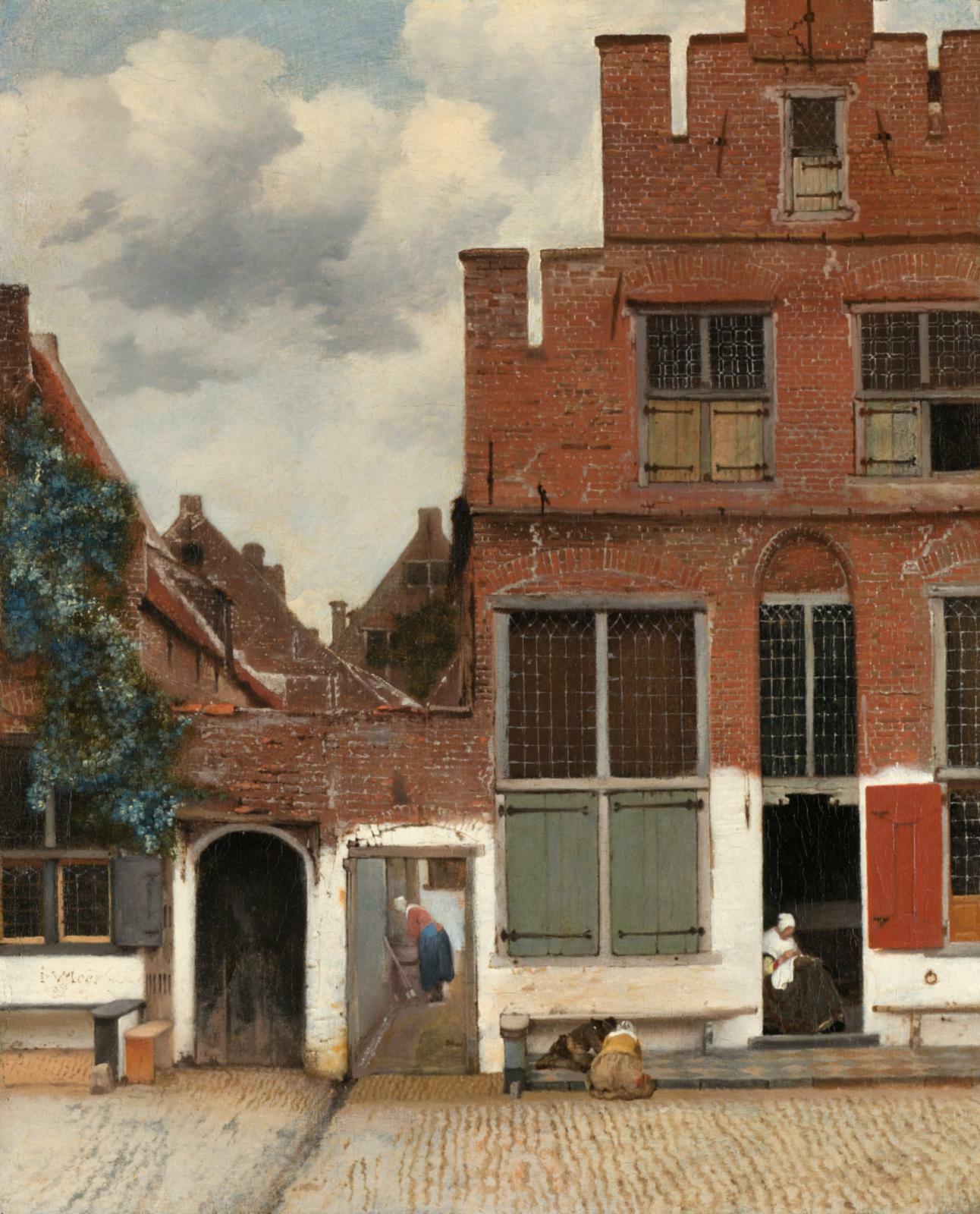
Jan (or Johannes) Vermeer – The Little Street (1657-1658)
Rijksmuseum - Amsterdam
SOME OF THE OTHER PLAYERS OF THE DAY |
|
Gustavus Adolphus's Sweden
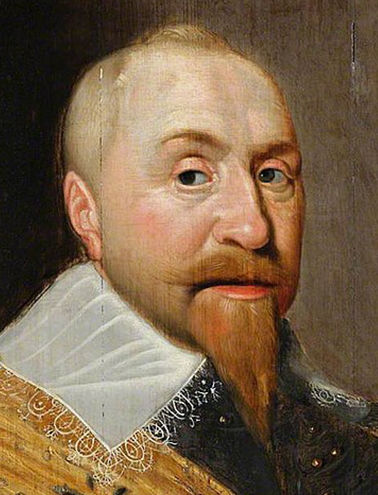 Under the kingship (1611 to 1632) of this exceptionally talented military commander,2
Gustavus Adolphus, Sweden in short order grew in status from being
merely a regional power to being one of the major powers of early 1600s
Europe. Pressing the Protestant cause in the Thirty Years' War or
Wars of Religion, he took on most notably the very Catholic Eastern
Habsburg Empire (the Holy Roman or Austrian Empire) ... and his
Catholic cousin, Sigismund, King of Poland and Grand Duke of
Lithuania. Much of the Thirty Years" War centered on this
competition between Sweden and the two huge Eastern European states of
Austria and Poland-Lithuania. Spain, Prussia and France also
weighed in big in the War. But Gustav Adolphus" Sweden seemed to
be at the heart of things.
Under the kingship (1611 to 1632) of this exceptionally talented military commander,2
Gustavus Adolphus, Sweden in short order grew in status from being
merely a regional power to being one of the major powers of early 1600s
Europe. Pressing the Protestant cause in the Thirty Years' War or
Wars of Religion, he took on most notably the very Catholic Eastern
Habsburg Empire (the Holy Roman or Austrian Empire) ... and his
Catholic cousin, Sigismund, King of Poland and Grand Duke of
Lithuania. Much of the Thirty Years" War centered on this
competition between Sweden and the two huge Eastern European states of
Austria and Poland-Lithuania. Spain, Prussia and France also
weighed in big in the War. But Gustav Adolphus" Sweden seemed to
be at the heart of things.
Interestingly, when Gustav Adolphus was killed in battle in 1632, his
five-year old daughter (his only surviving child) Christina took over
the Swedish throne ... focusing as much on learning and culture as her
father had on warfare. Meanwhile the business of state, as well
as the excellent Swedish military, was handed over to Christina's
Chancellor Axel Oxenstierna. He effectively governed Sweden until his
death in 1654. He not only maintained the strong military
tradition of Sweden, but worked hard at developing a modern bureaucracy
by which to govern the holdings of the Swedish Vasa dynasty.
Unfortunately
at this point (1654), when Christina abdicated, Sweden fell into the
hands of a less able king, Charles X Gustav, who continued to involve
Sweden in a constant round of battles in North-central Europe (Germany
and Poland) which ravaged the cities and countryside of the
region. However, he lived only a half-dozen years before passing
on the throne to his son Charles XI, who was largely a man of peace
during the next four decades..
The Polish-Lithuanian Commonwealth
In the mid-1600s the Commonwealth was assaulted from all directions,
but principally from the East by the Russians who overran the eastern
half of the Commonwealth and from the north by the Swedes who overran
almost all of the western half of the Commonwealth (the "Swedish
Deluge") ... the latter invaders creating such mayhem that nearly a
third of the Commonwealth's population died from military action,
hunger or disease. Worst hit were the cities (Warsaw lost about
90% of its population), hundreds of which were totally destroyed by the
invading Swedes. This began the rapid decline of the once-great
Poland-Lithuania, until both societies disappeared completely in the
late 1700s, absorbed by their neighbors Russia, Austria and Prussia.
Germany
We mention Germany at this point only to make the point that Germany
really did not exist as a political player in the 1600s. Instead
Germany was a collection of a vast number of kingdoms, duchies, cities
... in theory all under the authority of the Holy Roman Emperor ...
that is, the Habsburg Emperor of Austria. The reality was however
that the Habsburg Austrian Emperor governed effectively less than a
third of Germany (in the East and South of the German region).
The rest of Germany was made up of small mini-states under one or
another local ruler. This made for such weakness that Germany typically
served as the battleground for the various contending parties during
the Wars of Religion of the first half of the 1600s.
Germany was devastated by these ongoing wars ... losing over a third of
its population (in some areas far worse than that figure) ... through
the battles, the devastation of the land (again, in great part by the
Swedes) and the resultant hunger, and the diseases which accompanied
all of that. Unfortunately for Germany, it would remain a
victim-territory until well into the 1800s ... when finally (1870) the
Prussians (led by the skillful Chancellor Bismarck) would succeed in
uniting most of Germany as the Second German Empire.
2Many
– such as the Prussian Clausewitz, the Frenchman Napoleon and even the
American Patton – considered Gustavus Adolphus a military genius, and
studied carefully his use of heavy artillery, smaller but very mobile
infantry units, and speed rather than mass in the employment of his
troops.
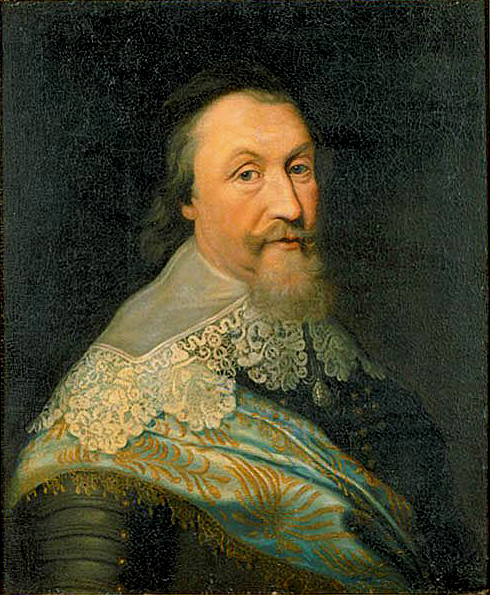
Axel Oxenstierna
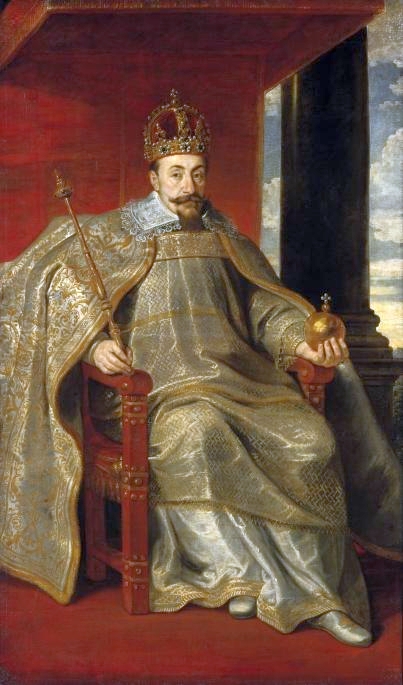
Sigmund III Vasa
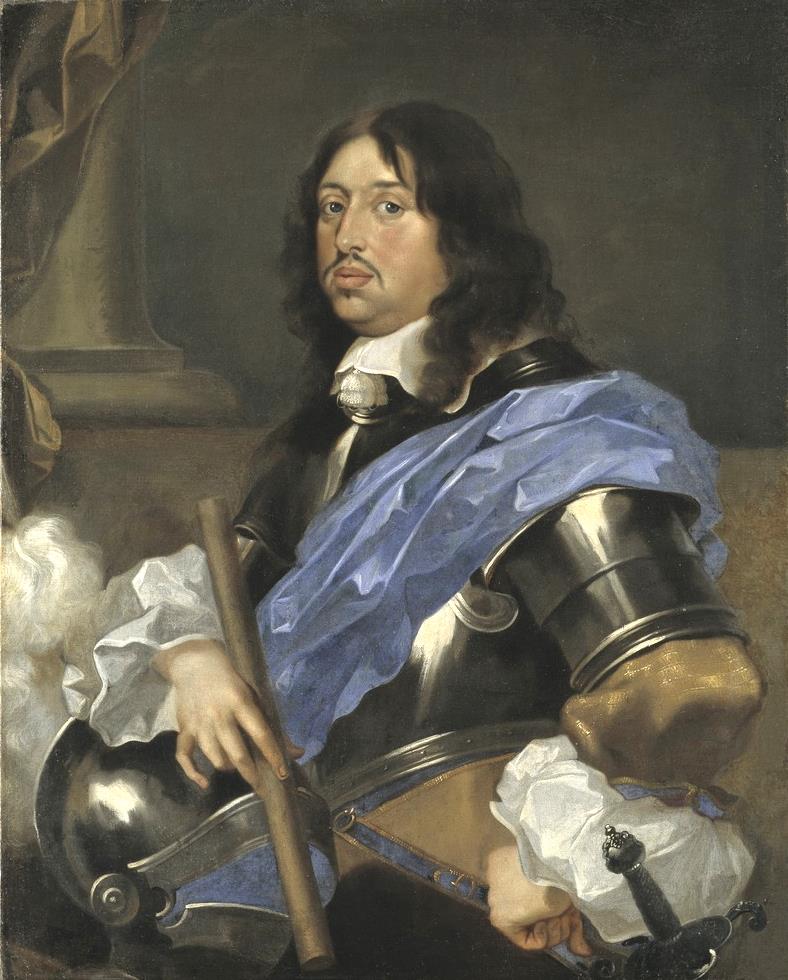
Charles X Gustav
ENGLAND OF THE STUARTS AND PURITANS |
|
James I Stuart and the Divine Rights Theory
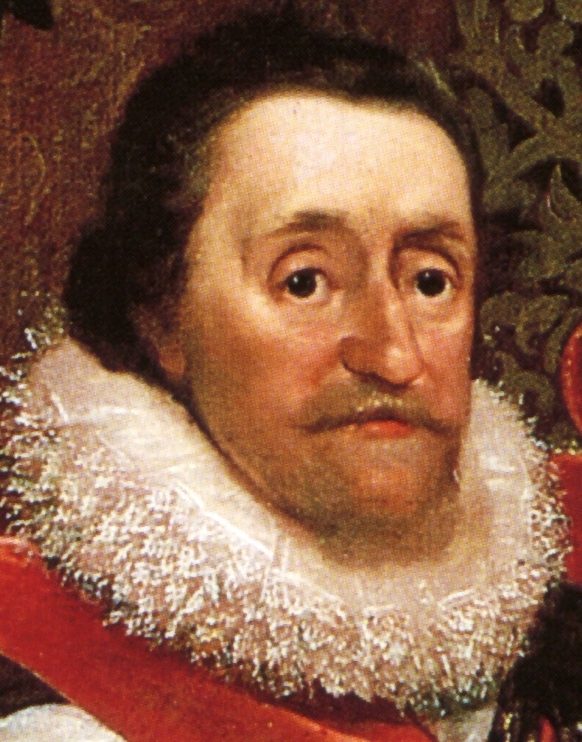 During the reign of Queen Elizabeth (1558-1603) there had been a
moderately tolerant working relationship between the Queen and the
Protestant (Calvinist) reformers. The burghers of London and
other English cities were for her an invaluable source of financial and
other support for her rule – which was continually on the defensive
against the likes of the "Catholic" defender Philip II of Spain.
During the reign of Queen Elizabeth (1558-1603) there had been a
moderately tolerant working relationship between the Queen and the
Protestant (Calvinist) reformers. The burghers of London and
other English cities were for her an invaluable source of financial and
other support for her rule – which was continually on the defensive
against the likes of the "Catholic" defender Philip II of Spain.
Lacking an heir of her own, it became apparent that Tudor rule would
eventually pass into the hands of the Stuarts of Scotland. Though
Mary Stuart had been an ardent Catholic, her son James had been raised
in Protestant (Calvinist) circles. In 1603 when Elizabeth died
and indeed James came to the English throne as James I, it might have
appeared that the going would henceforth be better for the Protestants
in England.
In
many ways James played to the Protestant reformers. He sponsored
a new English translation of the Bible (the venerable King James
version!), which pleased the reformers greatly (though the Puritans
seemed to continue to rely mostly on their beloved English-language
Geneva Bibles). He also was himself strongly opposed to the
re-opening of England to Catholicism – though mostly for political
reasons than for reasons of religious conscience.
But he also was a thorough royalist, strongly supportive of the "divine
rights" theory of monarchy by which the claim was put forth that kings
were responsible to God alone – and not to any human agency (such as
Parliament). Unfortunately, he would soon discover that
Parliament had a mind of its own and expected the king to share rule
with Parliament. Little by little tensions began to mount as the
King and Parliament came into conflict.
Part of his difficulty would be over the matter of religion. He
had during his earlier days as King of Scotland tired of the "upstart"
behavior of the Scottish Calvinists. He was now prepared to rule
directly over the Christian community in England – through an episcopal
system (a hierarchy of archbishops and bishops) that linked all the
Church of England to his personal rule as Head of the Church of
England. Thus was he much opposed to the idea of Presbyterian
government (the Calvinist idea of rule by "elders" or leaders from
among the commoner or burgher class) at the local level. During
his rule he actively discouraged the growth of independent or
"separatist" communities and congregations – that is, local communities
and churches that tried to work independently outside of the episcopal
system.
Overall, this was not a position all that different from Elizabeth's –
except that he lacked her political insights and thus found himself in
trouble on a number of fronts at the same time.
The development of Puritan power
Cambridge
University was at this time a hot-bed of Calvinist religious
thinking. Sons of prosperous English burghers came to this
venerable institution to explore a world of widening economic,
intellectual and spiritual opportunities. Here at Cambridge young
men began to fashion a purist or "Puritan" vision of a newly emerging
society, one operating directly under the sovereignty of God ... making
the place of the sovereign king a bit problematic. They supported
what was sort of a theory of "divine rights" of burghers – in
opposition to the "divine rights" theory of the monarchy. These
independent-minded scions of the burgher class came to see themselves
not as essentially subjects of the English crown, but as subjects of
God. According to their Calvinist or Puritan mindset, individuals
were to be led in living out their lives guided or governed only by
their own scripturally-disciplined minds and their own
prayerfully-cultivated Christian consciences. Nothing was to
stand between themselves and their beloved God. Not even an
English king.
Separatists and Puritans
It was not long before there was a
clash between Royalist and Puritan views – especially Separatist
views. Unlike the fellow-Calvinist Puritans, Separatists had
given up on the project of trying to reform the Church of
England. They concluded that the King was so adamantly opposed to
serious reform that there was no point in continuing to try to reform
the Church of England. Separatists were Puritans who simply were
ready finally to "separate" from the mother Church.
The other Puritans were not pleased with Separatism, considering the
Separatists as being something like traitors to the reform cause.
Puritans were not ready to give up the reform fight. Separatists
were.
One such group of Separatists, led by a Cambridge-trained pastor,
John Robinson, finally decided early on to leave England entirely and resettle
themselves in Holland (1608) where they could live in a Christian community
that operated in accordance with their Puritan principles. Some
of this same group would later (1620) make yet a second move as
"pilgrims" in pursuit of their dream, this time to the new world – to
Plymouth, Massachusetts. |
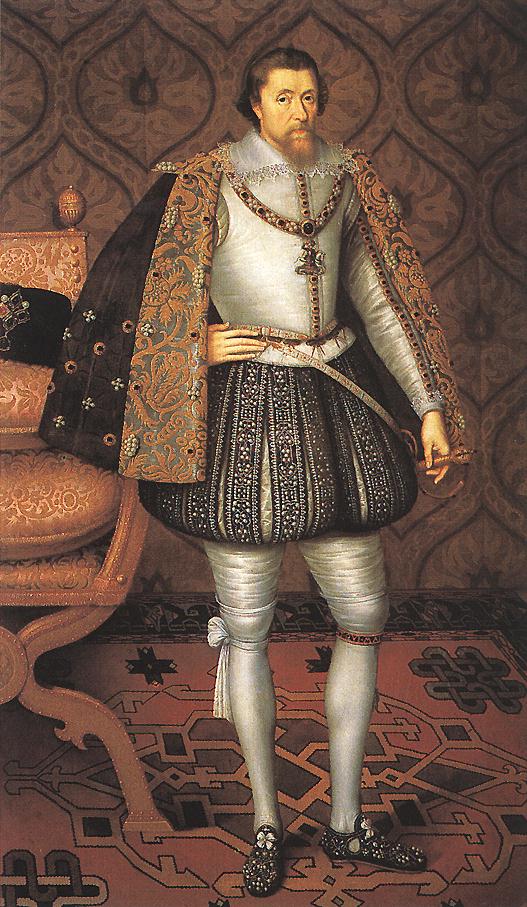
James Stuart - King of Scotland (1567-1625), and England and Ireland (1603-1625)
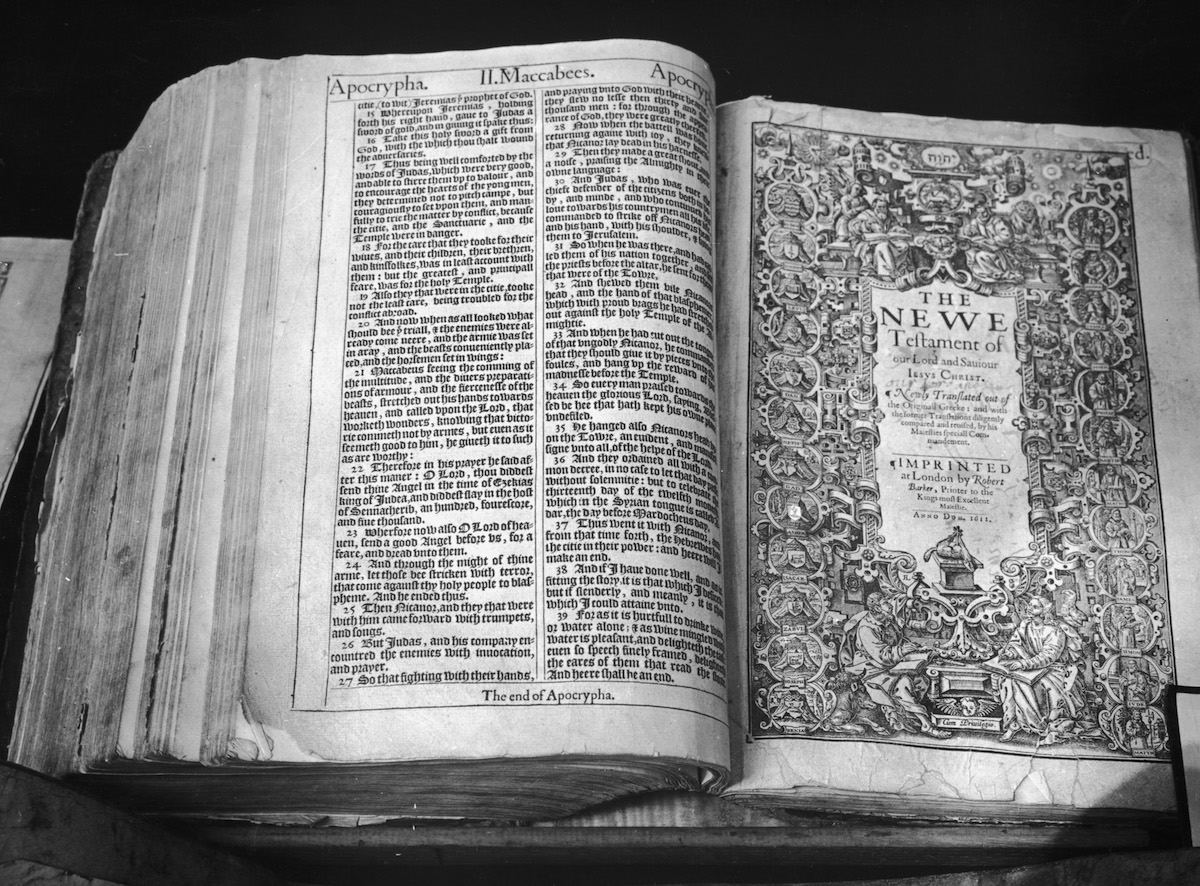
King James's "Authorized Version"
(actually most Puritans tended to hold on to thir beloved Geneva Bibles)
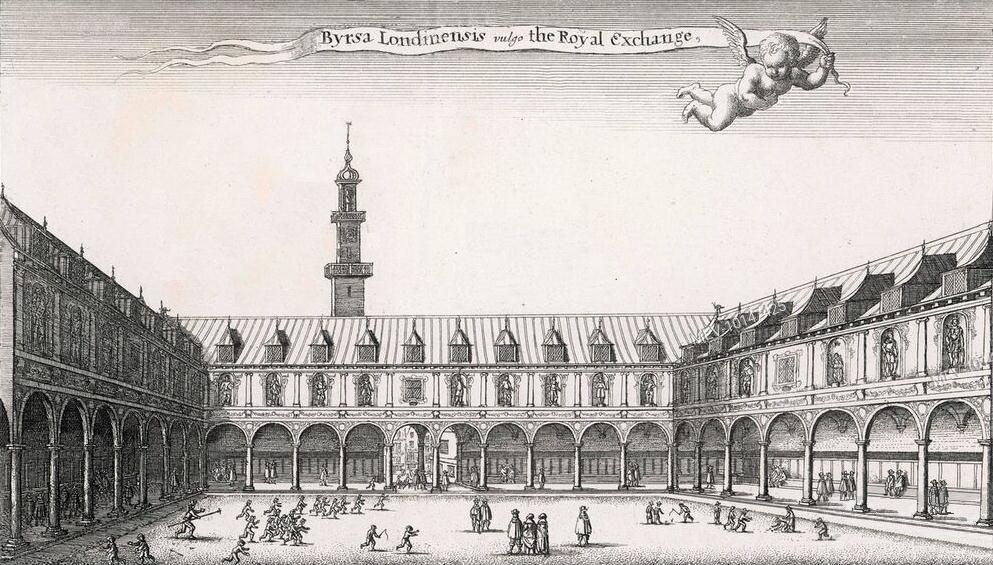
The London Royal Exchange (early 1600s) – where commercial fortunes were made (or lost)
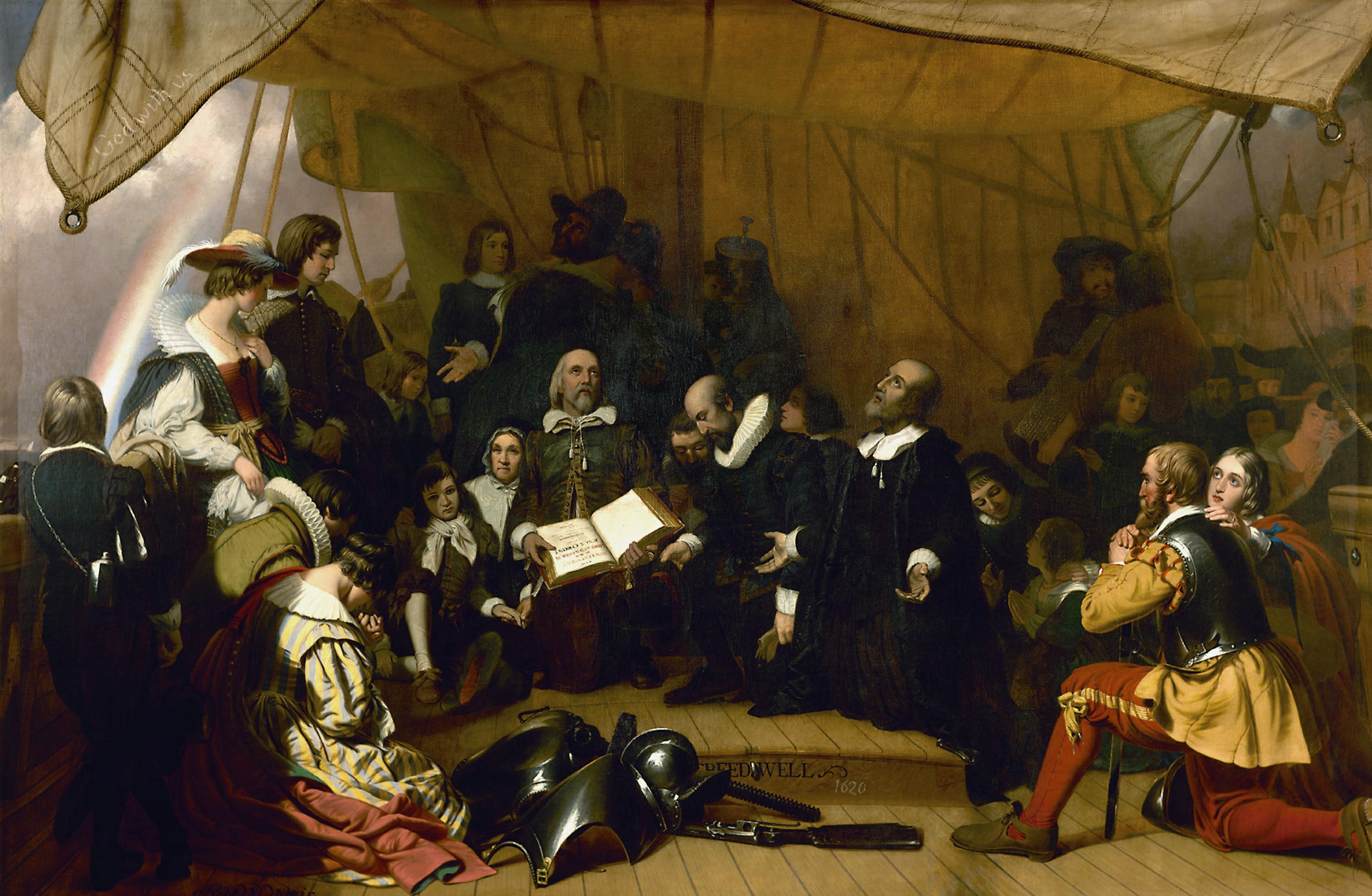
Pastor John Robinson leading the Pilgrims in prayer
prior to their departure for America -1620
|
Charles I (1625 – 1649)
When James died in 1625, his son Charles I came to power. Generally,
policies continued much as they had under James – except that the
debate over royal power was now widening and deepening in
intensity. On the continent the doctrine of royal absolutism (all
power rightly belongs to the king) was being aggressively put forward
in the French (Louis XIII) and Spanish (Philip IV) courts.
Inevitably the issue came to England.
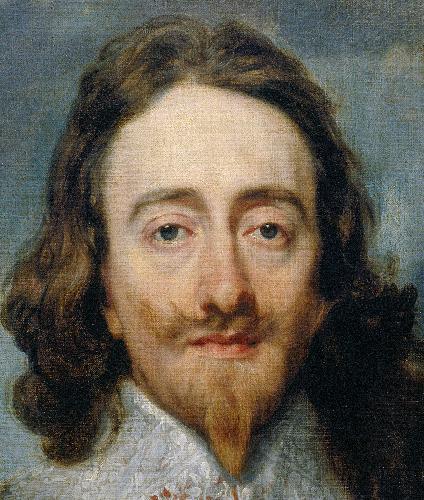
Charles immediately upon his accession to power brought an even more
aggressively royalist and aristocratic (or "cavalier") mood into
English politics. Charles favored the old landed families (many
of whom had Catholic sympathies) over the new independent minded
burgher (urban middle class) families in his appointments to the royal
court. In particular, he allowed himself to come under the
dominating influence of Buckingham, one of his father's advisors.
Buckingham was very much a royal absolutist – one who was inclined to
make no compromises with the burgher interests of Parliament.
Charles also stirred considerable political resentment by immediately
putting aside all the laws that had blocked Catholicism from English
politics. Likewise, his diplomacy of befriending Catholic kings
on the continent (even marrying his son to a Spanish princess) was
interpreted as the precursor of even reestablishing Catholicism in
England. This was not something that the Puritan majority in the
House of Commons would take lying down. The stage for violent
confrontation was thus being set even from the outset of Charles' rule.
Charles tried for 11 years to rule without Parliament – which meant
also ruling without the financial support of this powerful group of
English merchants. This forced him to take very contrived and
largely unsuccessful measures to raise his own monies in order to
maintain his royal courts and armies. Charles simultaneously
tried to engage in foreign ventures he hoped would rally the English to
his side. But tensions only mounted with the gentry who would not
play into his programs.
Rapidly Deteriorating Political Conditions
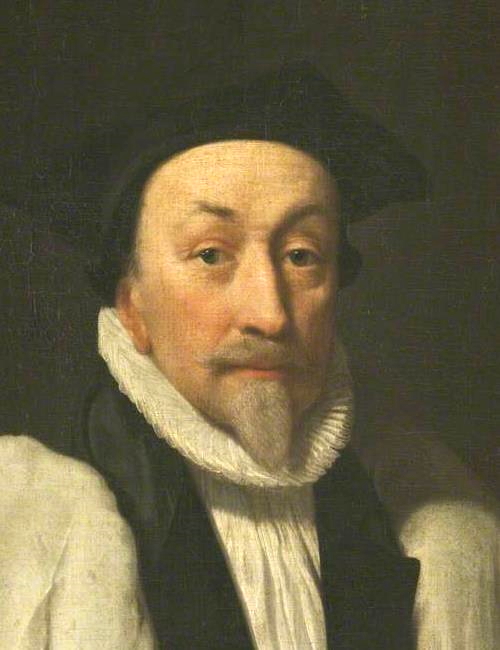 Charles eventually turned more and more to William Laud, archbishop of
Canterbury, for ideological support. The appointment of Laud, a
self professed Arminian,3 as Archbishop of Canterbury angered the
Calvinist Puritans enormously – who saw this as a move against their
own position (which it was!). Further, Laud's efforts to put the
entire Christian community in England under episcopal rule and in total
conformity to the Prayer Book only drove the wedge deeper between the
royal court and the Puritans in Parliament.
Charles eventually turned more and more to William Laud, archbishop of
Canterbury, for ideological support. The appointment of Laud, a
self professed Arminian,3 as Archbishop of Canterbury angered the
Calvinist Puritans enormously – who saw this as a move against their
own position (which it was!). Further, Laud's efforts to put the
entire Christian community in England under episcopal rule and in total
conformity to the Prayer Book only drove the wedge deeper between the
royal court and the Puritans in Parliament.
When a rebellion in Ireland flared up, the issue of who should control
the army came to the fore. Pym, leader of the more reformist
members of Parliament, narrowly succeeded in a vote to place the army
under Parliamentary authority. But Charles refused to
yield. With this, England found itself in a state of deep
political division between King and Parliament. It now had two
armies: the King's and Parliament's. Things were heading towards
a show-down.
But it was his Scottish subjects who would actually start the open
rebellion against Charles ... when he attempted to unite the heavily
Calvinist Church of Scotland with his Church of England. Specifically,
when Laud tried to impose the Prayer Book on the Scottish church, an
explosion in Scotland, Charles' home country, occurred. In 1639
Charles sent his ill paid royal army into Scotland to force
acceptance of this decree ... only to find himself met strongly by
Scottish forces.. A truce was agreed on, which Charles soon broke
in a second attack on Scotland the following year.
Parliament takes the initiative
Again, things went poorly for Charles in Scotland ... and desperate for
funding for his army, he called Parliament back into session in late
1640. But when Parliament put forth its own demands for the
undoing of Laud's episcopalian reforms in exchange for its cooperation
– the King dissolved Parliament (the Short Parliament)
immediately. But the king's situation only deteriorated and
soon he had to call Parliament (the "Long Parliament') back into
session. This Parliament would not be dissolved until 20 years
later. It was about to become the effective ruler of England.
Parliament now took action ... to remove (and subsequently execute)
Laud, to greatly restrict the King's ability to raise revenues, and to
make it impossible for the King to dissolve Parliament without its own
consent.
Charles at first complied ... hoping to avoid what was clearly becoming a drift toward war in England itself.
But the King fought back, especially when he saw division setting in
among the ranks of Parliament as to how to proceed, whether moderately
or radically. In early 1642 Charles moved to have five of
Parliament's leaders arrested ... but warned ahead, the five had
already fled when Charles showed up with an armed guard. This
event proved to be politically disastrous for Charles, now driving the
Parliamentary moderates into the arms of the radicals.
Fearing what might happen next, Charles immediately headed north.
But then in mid-1642 he decided to return to London. Some of the
country was coming out in support of him (basically the conservative
countryside) and he was hoping to force his way back into
supremacy. But urban England (and the navy) supported
Parliament. And thus the two sides gathered armed forces in
direct opposition to each other. The English Civil War was now
underway, initially taking the form of local battles here and there
around England.
The Civil War (1642 – 1649)
At first the war seemed that it should go in favor of Charles and his
"Cavaliers." But by 1643 the fortunes of war seemed to be turning
in favor of the Parliamentary troops and their army of "Roundheads"
(identified by their short haircuts ... in distinction to the long
curls of the Cavaliers, which was the fashion at the time in the royal
courts of Europe). Charles's army, though superior in size,
proved timid ... and gave the Parliamentary army an opportunity to
organize itself. Also, the Scottish army in 1643 came into the
struggle on the side of the English Parliamentary forces.
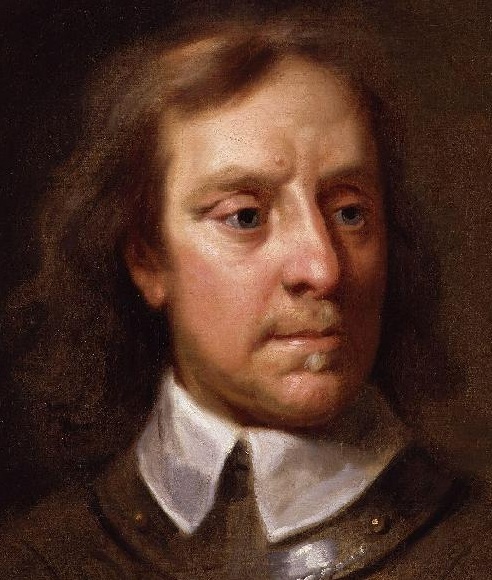 Finally, in 1644 the very capable Oliver Cromwell began to make his way
forward as a military leader. He mixed Puritan spiritual
discipline with incredible military discipline to produce a "New Model
Army" – which proved itself to be a powerful fighting instrument on
behalf of Parliament. In 1645, the entire Parliamentary Army,
reorganized along Cromwell's lines, met and crushed the royalist forces
at Naseby and Langport. The King escaped to Scotland,
surrendering himself to Scottish authorities, only to have them in the
following year (1646) – after receiving a huge payment from the English
– turn him over to the English Parliamentary authorities. With
Charles in prison the Civil War (at least its first phase) simply came
to a close.
Finally, in 1644 the very capable Oliver Cromwell began to make his way
forward as a military leader. He mixed Puritan spiritual
discipline with incredible military discipline to produce a "New Model
Army" – which proved itself to be a powerful fighting instrument on
behalf of Parliament. In 1645, the entire Parliamentary Army,
reorganized along Cromwell's lines, met and crushed the royalist forces
at Naseby and Langport. The King escaped to Scotland,
surrendering himself to Scottish authorities, only to have them in the
following year (1646) – after receiving a huge payment from the English
– turn him over to the English Parliamentary authorities. With
Charles in prison the Civil War (at least its first phase) simply came
to a close.
Disagreement within the Protestant ranks of Parliament
At this point a split occurred within the ranks of the Parliamentary
coalition. Most of the Protestant members of Parliament were
"Presbyterian" in persuasion and were willing to free the King in
exchange for the establishment of the Presbyterian form of church
government throughout England. But many of the English
Protestants, numerous in the Parliamentary army, were "independents" or
"congregationalists" and wanted local congregations to have the right
to organize themselves as they saw fit.4
This division led Charles to undertake from prison secret negotiations
with the very Presbyterian Scots, promising the very Presbyterian Scots
to institute Presbyterianism in England in exchange for support by the
Scottish army. Thus the character of the Civil War now shifted
into something of a nationalist struggle – an English Parliamentary
Army under Cromwell and a Scottish Presbyterian Army supporting Charles.
But again, in this second phase of the civil war (1648-1642) things did
not go well for Charles ... or the Scottish Presbyterian army.
Also Charles had been counting on his former supporters in England to
retake arms. But most refused (having previously promised under
oath not to do so). Those that did were quickly seized ...
and beheaded (for breaking their oath).
The Rump Parliament
This led to the question of what to do about the King. The matter
was quickly decided by the army itself when it marched on Parliament
("Pride's Purge") and arrested the MPs who had been willing to work out
a compromise with the King and blocked the entrance of most of the
rest. The small number of MPs remaining (only 75 of the original
470 members of the Long Parliament)5 were ordered to set up a High Court
of Justice to try the King on charges of high treason.
The King is beheaded (1649)
Fearing that the King and the Presbyterians might work together to
create a new pro-royalist Presbyterian Parliamentary army, there was
only one verdict likely to be forthcoming from just such a court.
Thus in January of 1649 the court found Charles guilty as charged ...
and at the end of the month the King was beheaded.
The nation was shocked – but subdued by this show of power. In
any case, this effectively removed the rallying cause for opponents of
Cromwell and his army of Independents.
Charles II is proclaimed King ... but flees to France
Nonetheless, his eighteen-year-old son (also "Charles') was immediately
proclaimed by the Royalists as King of England, Scotland and
Ireland. Royalists in all three countries attempted to take power
in the name of the new king. But all this did was to return all
three lands to violent civil war.
Reacting to the announcement of Charles II's assumption of royal rights
in Scotland, the Rump Parliament now moved to abolish the monarchy and
the House of Lords, declaring England under a newly drafted
Constitution to be a Commonwealth directed by a Council of State.
Actually it was Cromwell and his army which were in effective control
of England at this point.
3The
Dutch Reformer Jakob Arminius (1560-1609) questioned the strict
Calvinist (Pauline) understanding that salvation was by grace extended
by God alone … not by human good intentions or good works. His
supporters, the Remonstrants, insisted that salvation was at least in
part a matter of the free choosing of the individual. A Dutch
synod held at Dort in 1618-1619 – attended by Calvinists from other
parts of Europe – opposed strongly the Remonstrants and their
"Arminianism."
4As previously
explained, Presbyterians supported the idea of a system of church
unions, all the churches at the local or regional level constituting a
Presbytery, a number of Presbyteries joined together to constitute at a
higher level a Synod (Senate), and the Synods united into a General
Assembly. Positions of membership and leadership in these bodies
were entirely elective on a regular (even annual) basis by church
members ... to ensure a democratic character of the whole (unlike the
episcopal system of church appointments from the King on down to the
archbishops to the bishops). The independents or
"Congregationalists" wanted to have no part of any higher union above
the local churches, each of which was supposed to be entirely
self-running. The difference between the Presbyterian and
Congregationalists was thus political, not religious, because both
groups were strong Calvinists theologically.
5Actually
the Rump Parliament would see the gradual return of almost half of the
original Members of Parliament ... most of whom considered the other
half to be still fully Members of Parliament – and hoped to see some
kind of compromise able to bring about their return.

Charles I
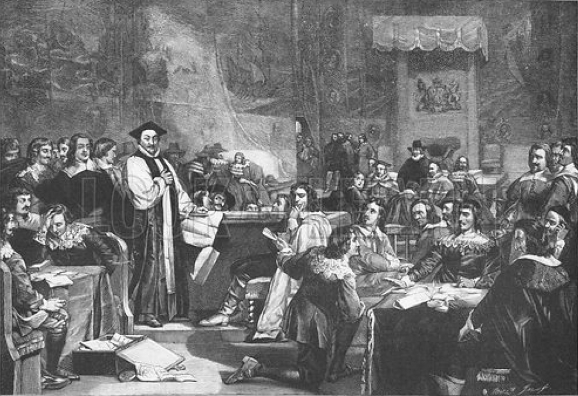
The Trial of Archbishop Laud - 1644 (he is beheaded on January 10, 1645)
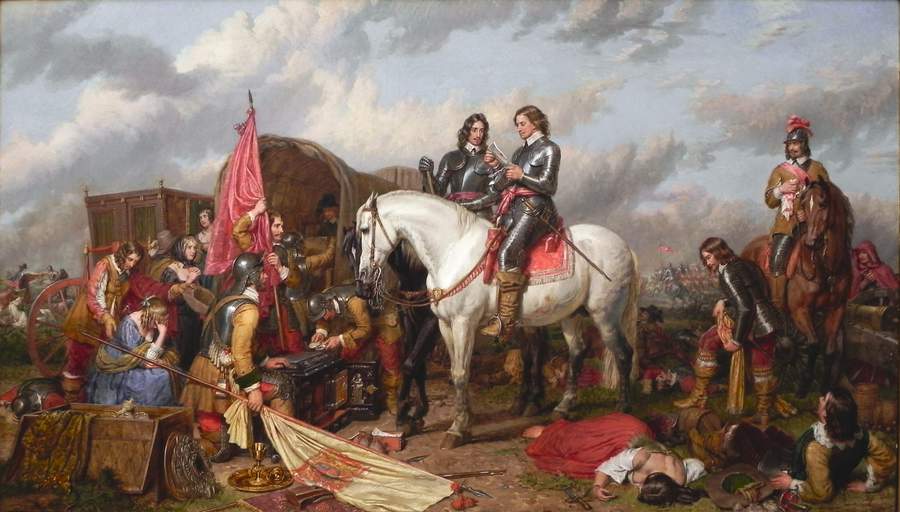
Cromwell – having captured Charles's personal baggage and correspondence
at the Battle of Naseby (June 14, 1645)
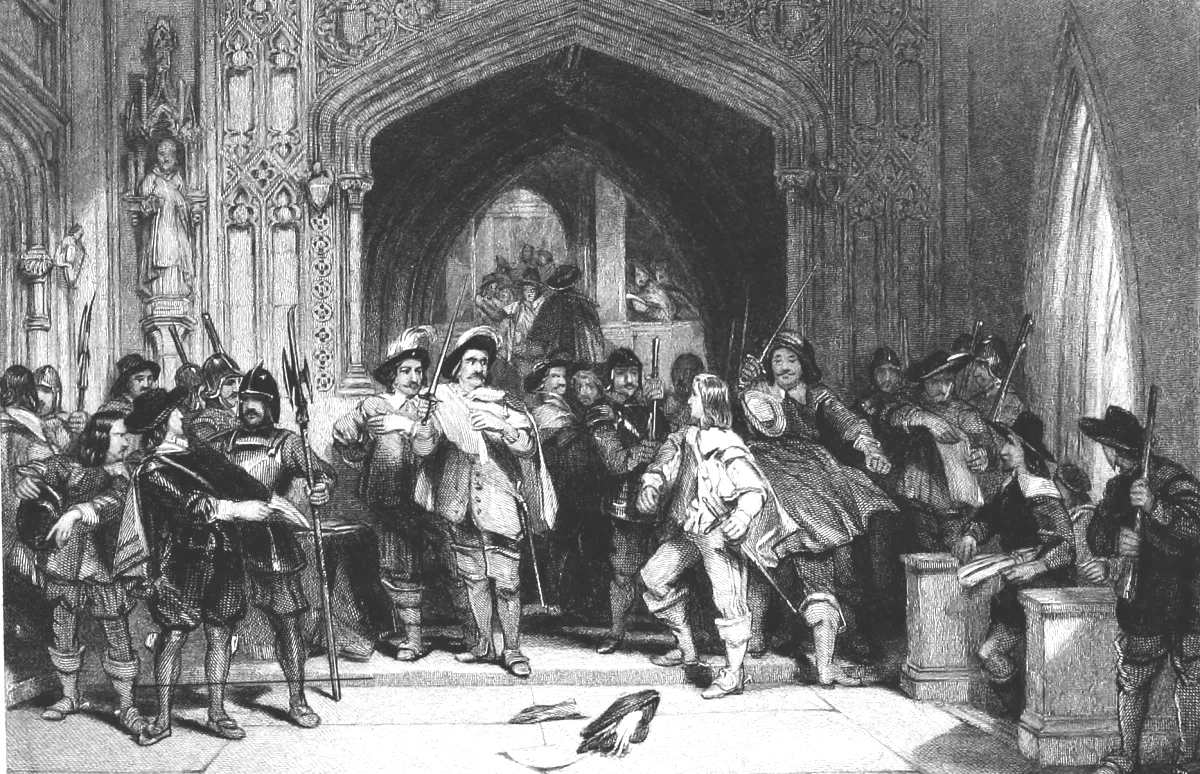
Pride's Purge of Parliamentary members - December 6, 1648
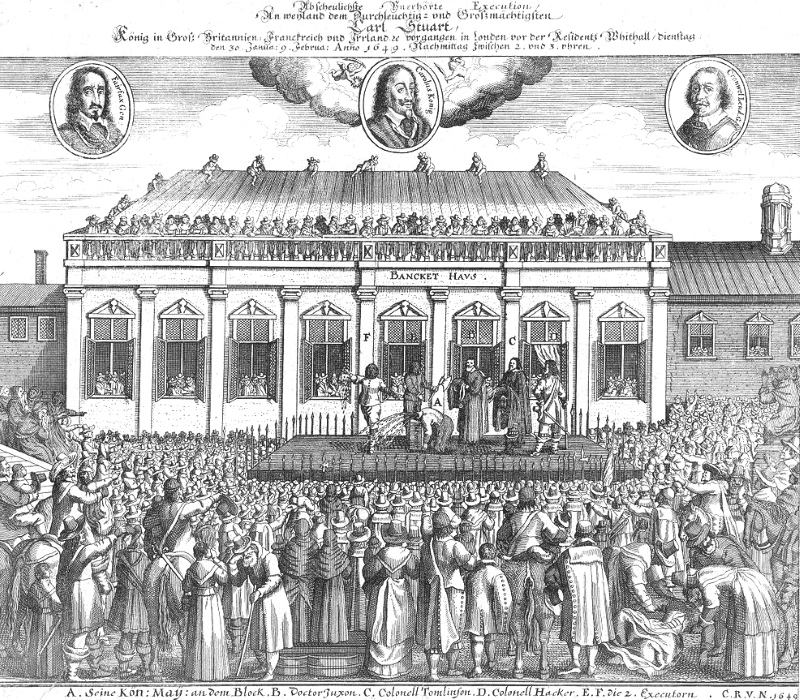
Charles I is beheaded (1649)
Spain
had not appeared as interested in North America in its efforts to bring
the Western Hemisphere under Spanish control and therefore that area
seemed to offer the best possibilities for others to get in on the
act. By the beginning of the 1600s it seems that the time was
right for others to do exactly that – particularly after the Spanish
army and navy had experienced a string of disastrous setbacks trying to
keep both their Dutch subjects from breaking away from Habsburg
authority and the English privateers (actually merely pirates
officially authorized by English Queen Elizabeth) from harassing
the Spanish fleets bringing gold from America. Thus (as we have
already seen) the French sent traders to Canada to take advantage of
its great wealth in animal furs – and sent priests to Canada to bring
Indian souls to Christ. Also the commercially minded Dutch set up
a merchant orporation to bring back the wealth of the central
shores of North America – and to find passage through America to Asia,
hopefully up the Hudson River where they positioned some Dutch
settlements.
The Virginia Company
A strictly commercial venture. Likewise the English formed a similar merchant corporation, the
Virginia Company, to do the same for the area along the shores of the
Chesapeake Bay. In 1607 a small fleet set out to site a colony
named Jamestown along the James River – both named after the English
King, James I. The motif of the venture was the same as it had
been for the Spanish: for the adventurers to find Indian gold and thus
secure their positions as rising noblemen ... or at least as something
like "gentlemen."
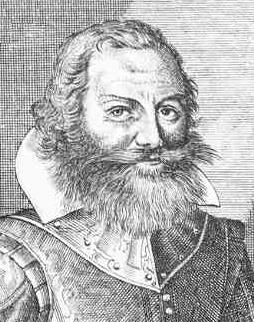 However gentlemen did not perform manual labor – which presented a
problem for the Virginia Company, as most of the participants in this
venture were attempting to establish for themselves ratings as
"gentlemen." John Smith succeeded in making himself unpopular by
commanding his fellow merchant adventurers to take up necessary labor
if they hoped to eat. Some had brought along indentured workers
to do the work for them. But most of the adventurers attempted to avoid
the responsibility of manual labor. As a consequence the new
plantation at Jamestown suffered tremendously from the lack of
food. This, plus not taking the time to properly site the new
colony (they put it alongside a mosquito-laden swamp) caused the
adventurers to sicken and then die in droves. More workers were
brought in, but the venture had enormous difficulty trying to function
as a successful settled community.
However gentlemen did not perform manual labor – which presented a
problem for the Virginia Company, as most of the participants in this
venture were attempting to establish for themselves ratings as
"gentlemen." John Smith succeeded in making himself unpopular by
commanding his fellow merchant adventurers to take up necessary labor
if they hoped to eat. Some had brought along indentured workers
to do the work for them. But most of the adventurers attempted to avoid
the responsibility of manual labor. As a consequence the new
plantation at Jamestown suffered tremendously from the lack of
food. This, plus not taking the time to properly site the new
colony (they put it alongside a mosquito-laden swamp) caused the
adventurers to sicken and then die in droves. More workers were
brought in, but the venture had enormous difficulty trying to function
as a successful settled community.
Tobacco to the rescue.
No gold of any significance was to be found in Virginia. But an
entrepreneurial individual, John Rolf, picked up some tobacco seed when
at first stranded in Bermuda and then was able to bring his discovery
along with him to Virginia ... and start up what became a very thriving
tobacco industry. Others caught on, and soon tobacco farming and
shipping back to England became the economic mainstay of Virginia.
A Virginia aristocracy develops on the European model. However the colony began slowly to settle in ... and develop a degree
of social order. In 1619 a governing Assembly (the House of
Burgesses) representing all male landowners in Virginia gathered in
Jamestown as the first elected government in English America.
However it was understood that the representatives themselves to the
House of Burgesses were naturally to be drawn from the class of local
Virginia aristocrats or gentlemen owners of the major Virginia
plantations. Virginians held the social or cultural understanding
that it was the proper thing to do in deferring to one's social betters
– just as one did back in England.
Then in 1622 a major Indian attack which resulted in the death of some
300-400 colonists – and rumors of the deputy governor's mismanagement
of the colony – caused King James to end the Virginia Company's charter
in 1624, converting it into a royal colony directly under the King
himself (but governed by a royal Governor appointed by the King.)
The House of Burgesses continued to meet, though its power was reduced
somewhat. But the real power of the royal colony was now located
in the Governor's Council consisting of the Governor and a small group
of advisors drawn from the wealthiest Virginia plantations (the
Virginia aristocracy).
Servitude and Slavery
Despite
the emphasis placed on the event of 1619 when some 20 Angolan Africans
were brought to Virginia as slaves, slavery was hardly a novel
institution in the New World. It had been going on, particularly
in the nearby Caribbean Islands, for a century. And it simply fit
right into the idea that there were two classes of people at the time,
property-owners, and those who worked that property. Indenture
and slavery had much in common, in that those who fit the category as
either indentured worker or slave had no particular rights of his or
her own under that category. Even indentured workers were
considered the "property" of the person ("master") possessing their
indenture ... an indenture that could be bought and sold to other
wealthy owners if need be. But there were some key
differences. A person usually chose to accept indenture in order
to receive funding to cover the cost of the trip to America ... and
with the understanding that at the end of the tenure of the indenture
(usually seven years) that individual would receive not only the
training developed during the indenture but also land rights and tools
to allow himself (or herself) then to set himself up independently in
the New World. Slavery had no such options ... but involved a
lifetime of service ... and a similar servitude passed on to any
offspring of such slaves.
Actually at first, slavery in Virginia was not a tightly defined
institution ... some Africans actually being classed as indentured
workers – presuming that upon attaining personal freedom, they would be
able to take on indentured workers of their own. But with time
(the later 1600s and certainly by the beginning of the 1700s) slavery
became a fully-legalized part of the Virginia social scene ... and
identified most closely with those of African origin.
Virginia's God
Despite this rather "un-Christian" picture of the very rich lording it
over the poor, both black and white – Virginia was not Godless.
Attendance at church (the Church of England directed by the King and
the bishops he appointed) was required of everyone. But there
were few pastors that accompanied the early settlers to Virginia and,
as in England, attendance at worship was viewed more as a duty than as
a right or privilege. Ultimately Virginia was no more or less
religious than most of "Christian" Europe of those days.
|
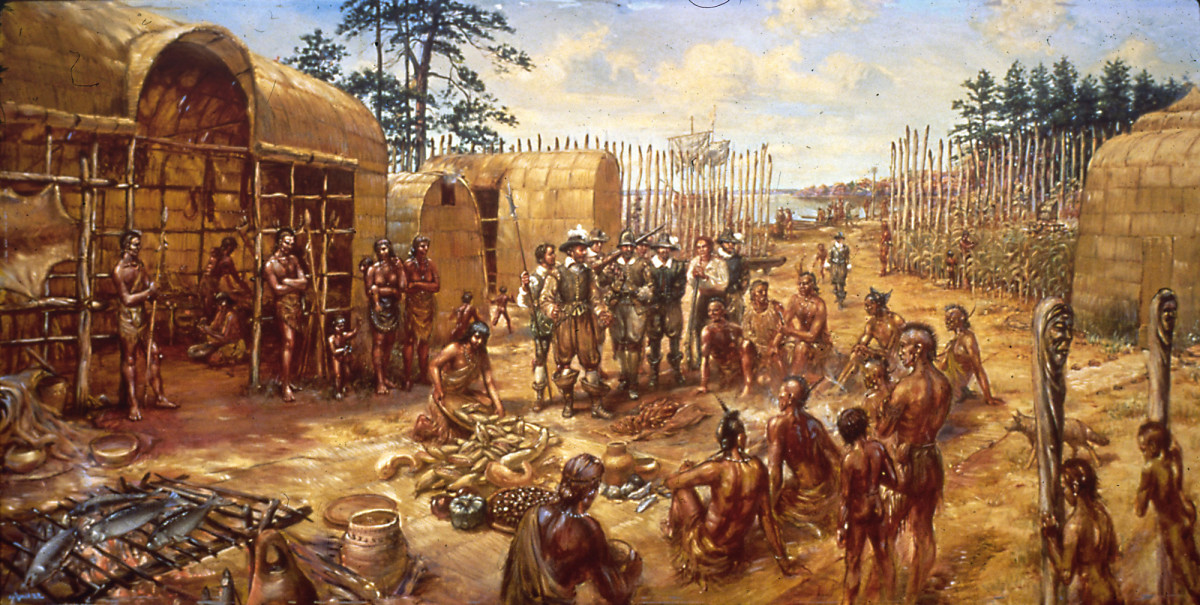
The Arrival at the future Jamestown
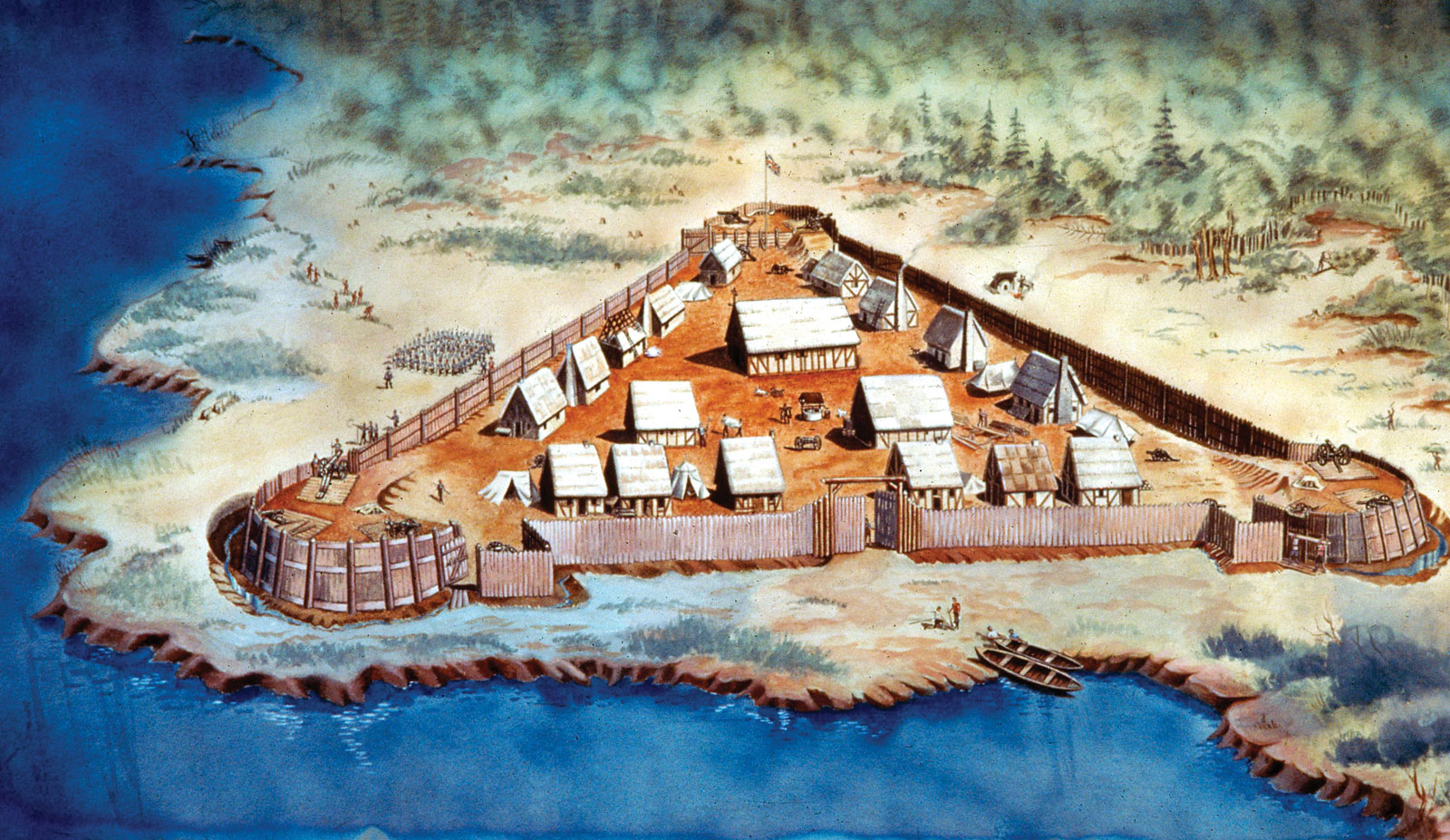
The Fort at Jamestown
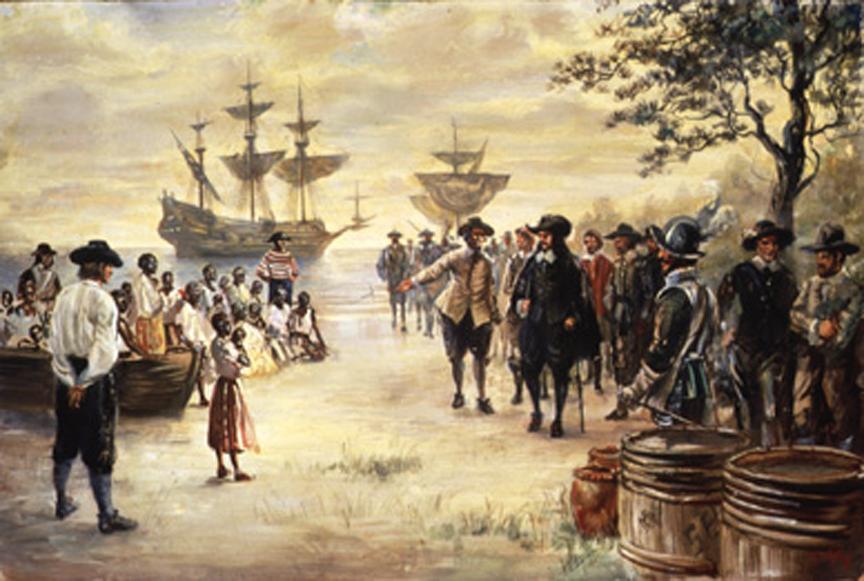
Africans (Angolans) for sale at Jamestown – 1619
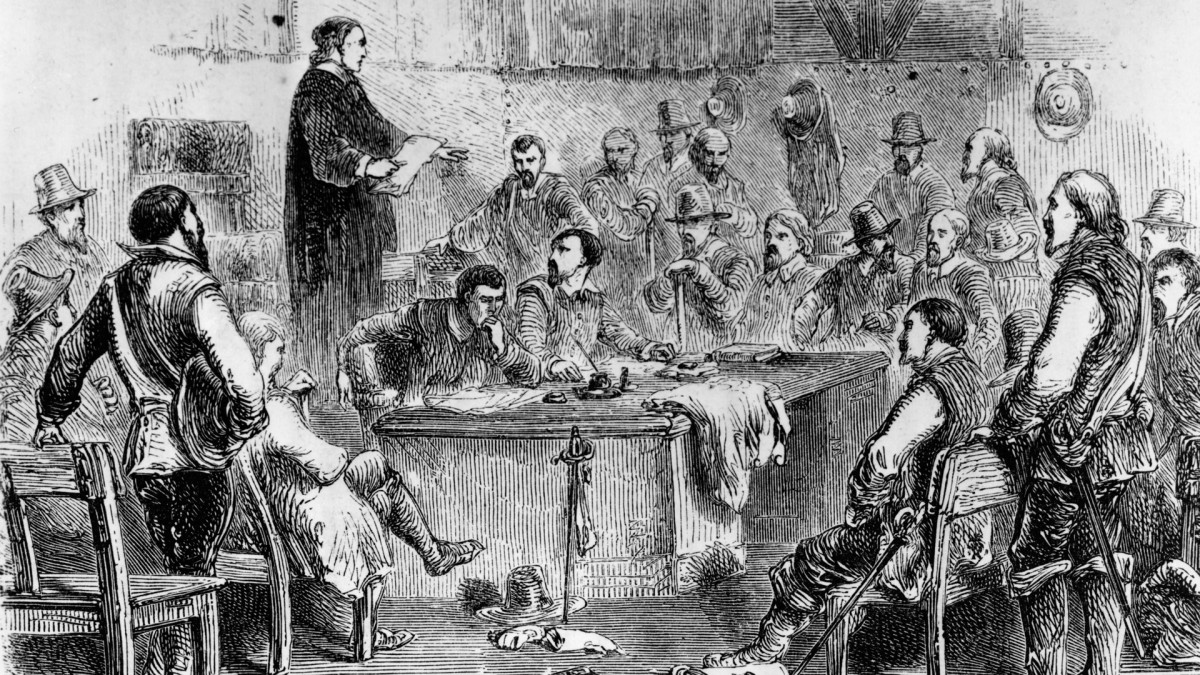
A meeting of the Burgesses at Jamestown
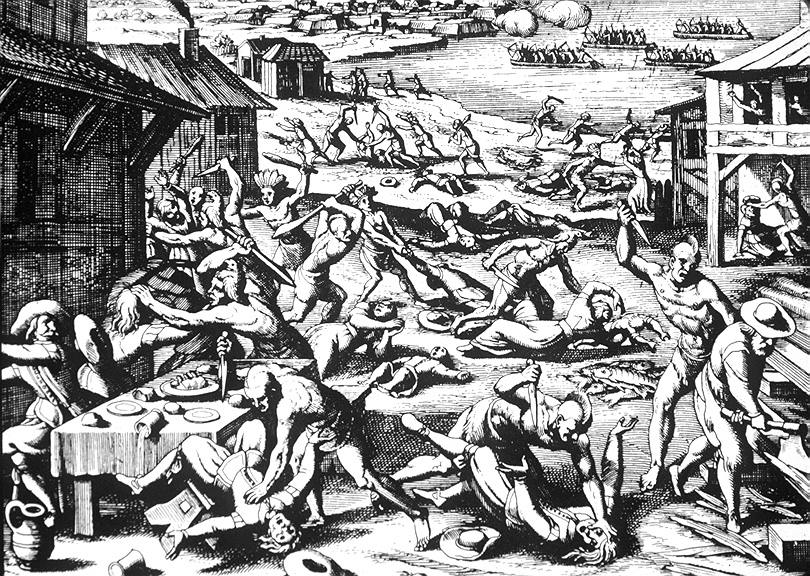
The Indian attack on the Virginians - 1622
|
New England
Meanwhile to the north of the Virginia colony in an area that would
come to be known as "New England" an English settlement of quite a
different character was taking shape. Whereas the Virginia colony
was from the very outset an experiment in social improvement through
the acquiring of wealth and thus status in a largely feudal cultural
setting, New England was a definite religious experiment based on the
strong religious feelings stirred by the Protestant Reformation in
England. New England was an experiment in building a "reformed"
society, from the ground up, according to strict Biblical
principles. It was an experiment in building a "New Jerusalem," a
"city on a hill," able to shed Christian light to the rest of the world.
The Separatist "Pilgrims"
The first to make the move to New England in this matter would be a
group of Separatists ... who would gain for themselves the title of
Pilgrims, for their world was indeed a world of pilgrimage – religious
pilgrimage. Under the threat of imprisonment for their religious
"treason," a small community of Separatists escaped to the Netherlands
to live among fellow Calvinists like themselves. But it was a bad
time to be looking for help in the Netherlands, as the Dutch were fully
occupied at trying to keep themselves from being destroyed by the
Spanish troops that had invaded their country. Thus economic hard
times – plus watching their children abandon their English heritage as
they began to take up Dutch culture – decided a number of these English
Separatists to make yet another move: to America.
After political and economic complications with English investors and
with royal authority, plus missteps in getting themselves across the
Atlantic so late in the season (November 1620), these Pilgrims were
able to set up a new community just opposite Cape Cod in the area known
as Massachusetts. Here with the help of friendly Indians they
were able to found the colony of "Plymouth" ... and begin to live out
the religious experiment they had long been seeking.
The Puritans join them
With so much persecution back in England after Charles took the throne
as English King in 1625 ... the Puritans who had looked down on the
Separatists as traitors to the Reformed cause now themselves realized
that "separation" was the only option available to them ... short of
civil war. Thus in 1630 and for the next ten years after that,
some 20,000 Puritans left England and sailed to America to found and
develop there the Massachusetts Bay Colony, just to the north of the
Plymouth Colony.
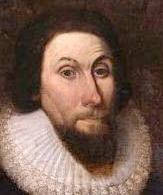 John Winthrop.
Organizing, leading, and serving as the spiritual mentor to this
venturesome group of Puritans, was Winthrop. He led the first
group of 1000 Puritans to the Boston area, was quick to link up with
the Plymouth Pilgrims, and thus was to learn from them some of the
secrets of survival in this strange new world. John Winthrop.
Organizing, leading, and serving as the spiritual mentor to this
venturesome group of Puritans, was Winthrop. He led the first
group of 1000 Puritans to the Boston area, was quick to link up with
the Plymouth Pilgrims, and thus was to learn from them some of the
secrets of survival in this strange new world.
These Puritans were not economic refugees or social climbing
adventurers. They came from stable Middle Class English stock
which (unlike the Virginians) had developed the Calvinist attitude
toward hard work as not only the way to please God but also the way to
build for themselves and their families fairly prosperous lives.7
They were literate (the ability to read the Bible was an absolute requirement) ... indeed, well-educated in the three "R's" (Reading, wRiting and aRithmatic),
and well led by university-educated (usually Cambridge University)
clergy, with usually just such a pastor assigned to each of the many
New England villages.8
The Massachusetts Bay Company, which sponsored this mass movement of
Puritans, carefully laid out each new village with a certain size of
population and a specific allotment of farmland, complete with a
"meeting house" at the center of each village – serving as a church on
Sundays, a school for children during the daytime on weekdays, and a
hall for town meetings as needed in the evenings.
A deep sense of the equality of all (reflective of their understanding
that all are esteemed as equals in the eyes of God) stood at the heart
of the social agenda of New England. These Puritan/Separatist New
Englanders worked together as equals, studied together, and defended
themselves together (such as the "minute men" who were trained to
assemble from their fields or homes in a moment's notice if the village
were threatened ... usually by an Indian attack).
Being able to work as a community, except for the Pilgrim's very first
winter when the Pilgrims lost half their number due to winter exposure,
there would be no "dying time" such as the Virginia Colony experienced
repeatedly. Thus the New England colony prospered well beyond the
level of the Virginia colony ... and grew accordingly.
7This was the origins of the famous "Yankee work ethic" for which Americans would become world famous.
8Thus it was that
Harvard College was founded (1636) in Boston shortly after their
arrival to America, primarily to educate just such pastors. The
heavily Episcopalian Virginia would not do the same (College of William
and Mary) until almost the end of that same century (1693).
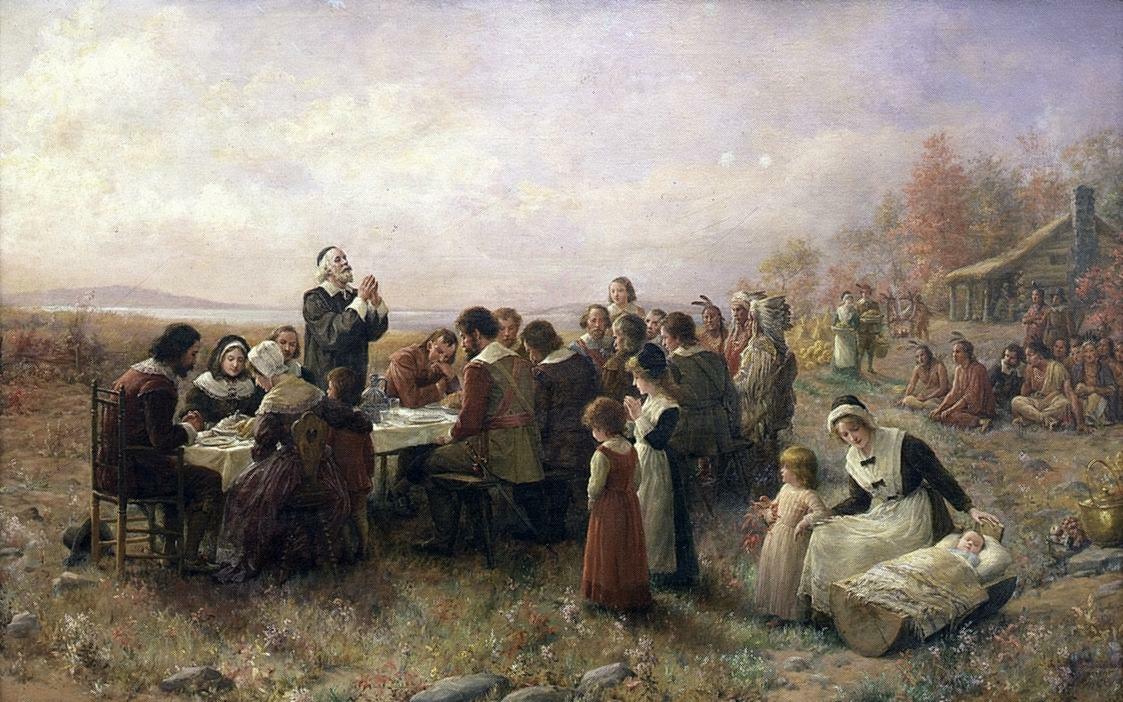
The first Thanksgiving of the Separatist Pilgrims - 1621
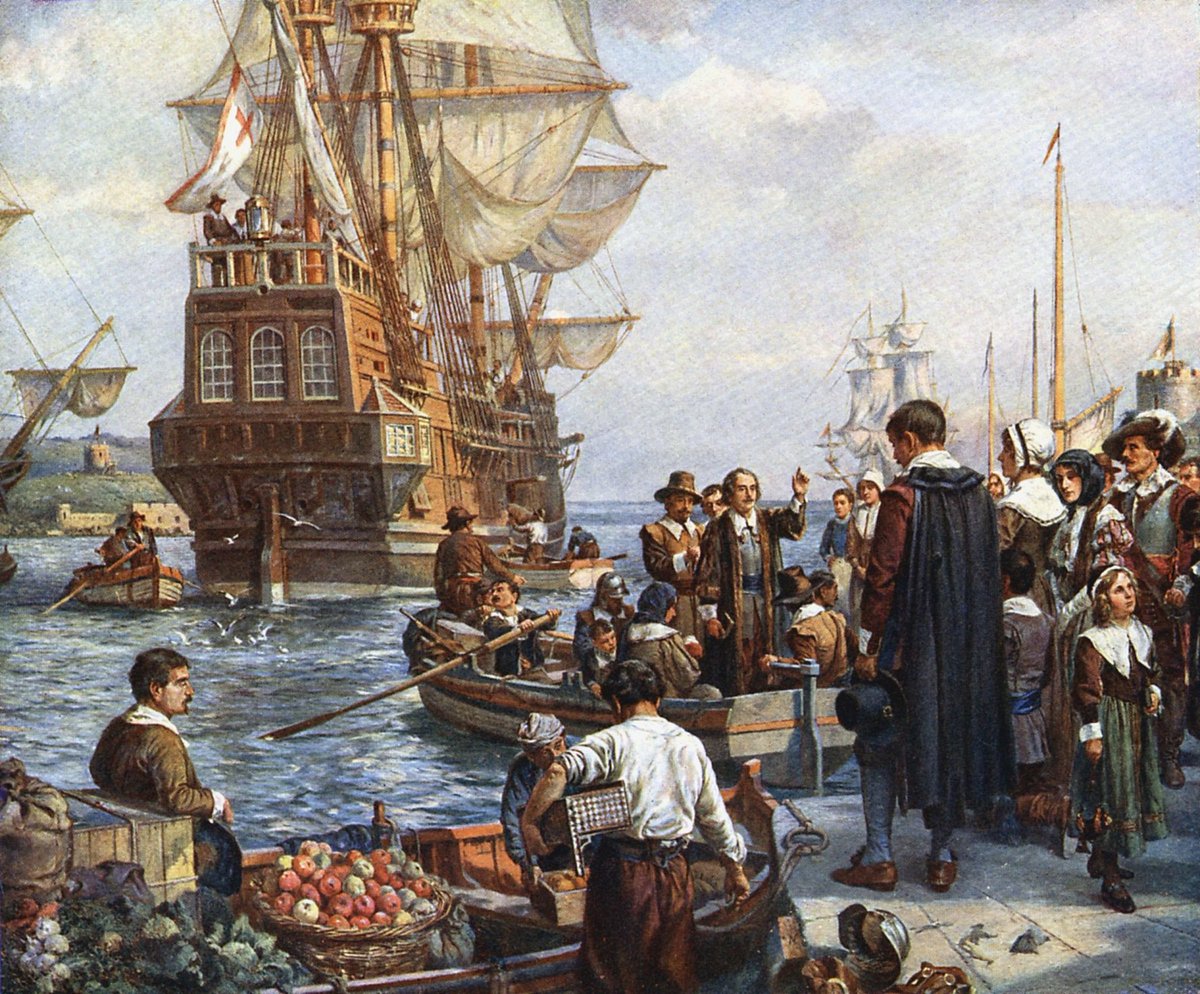
Winthrop and his Puritans depart for America - 1630

Puritan worship in Massachusetts
Roger Williams and Anne Hutchinson
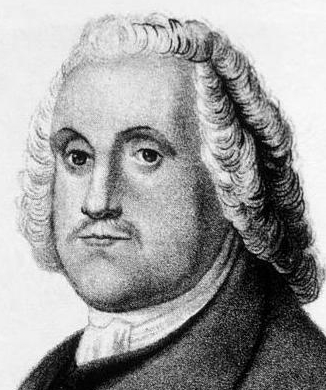 This is not to say that New England did not have its problems. People
brought their personal issues with them to New England, such asthe
pastor Roger Williams ... for whom the Puritan settlements were never
religiously "pure" enough and who finally was invited in 1636 to take
his purity elsewhere ... though in establishing his own colony of
Providence (Rhode Island) he quickly ran into many of the same problems
himself and soon restored a close friendship with Massachusetts' leader Winthrop. This is not to say that New England did not have its problems. People
brought their personal issues with them to New England, such asthe
pastor Roger Williams ... for whom the Puritan settlements were never
religiously "pure" enough and who finally was invited in 1636 to take
his purity elsewhere ... though in establishing his own colony of
Providence (Rhode Island) he quickly ran into many of the same problems
himself and soon restored a close friendship with Massachusetts' leader Winthrop.
And there was Anne Hutchinson who believed herself to
be more "spiritual" than the colony's pastors – except for the pastor
John Cotton, whose favor she cultivated with breathtaking flattery.
Eventually, in 1638, she was forced to leave the colony ... before her
"prophetic pronouncements" shattered the social foundations on which
the struggling new community was built.9
9Anne
Hutchinson would become a major hero of the American feminist movement
for the way she stood up to the male authorities of the colony,
attempting merely to "exercise the right of free speech." The fact
that she created a circle of individuals who were deliberately
attacking the legitimacy of the colony's leadership with their claims
that all the pastors but Cotton were serving the Anti-Christ or Devil is a most critical social matter conveniently overlooked in the extolling of Hutchinson's "bravery."
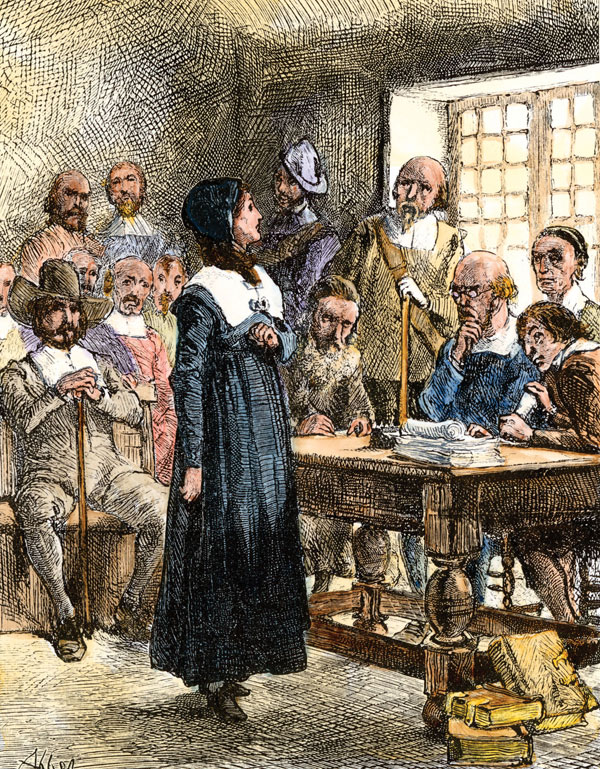
The Trial of Anne Hutchinson - 1638
A MAJOR INTELLECTUAL SHIFT |
|
Religious Fatigue
It is impossible to overstress the importance of two factors that
played heavily in the lives of Westerners by the year 1650.
One
of these was a growing sense of relativism about revealed or divine
truth. Watching
Protestants and Catholics slaughter each other in
the name of revealed truth did nothing beneficial for cause of either
"revealed truth" in the long run. Instead it tended to scatter
the seeds of religious skepticism around the land. People were
tired of the fiercely combative religious claims on people's sense of
truth.
Consequently, the simple straightforwardness of truth built merely on
human observation and reason seemed to be a much more useful – not to
mention safer – approach to truth. The European was thus very
receptive to a worldview which grew up from the foundations of "natural
philosophy" – one that proceeded not from tradition, or scripture, or
divine revelation, but one which seemed to stand simply on observed
"fact." This was truth enough. This could even be, as in
the example of the theory of the heavens, a greater truth. The
European was thus beginning to be very open to what such natural
philosophy (the forerunner of modern science) might now be having to
say about life ... anywhere, everywhere – even in the heavens above.
The development of the secular-scientific mindset
The second factor playing a very big role in the development of Western
culture in those days was the growing interest in the immediate world
around us – the physical, secular world. Somehow there was a growing
sense that it was not a mere transient place – merely a staging area
for eternal life. Rather – it had value, great value, in and of
itself.
True, this kind of thinking had its roots as far back as the 1300s,
with its love of physical beauty found in the human form and the
natural world around us; and it developed rapidly in the 1400s during
the Renaissance in Italy and Northern Europe with the rise of the
spirit of entrepreneurship and the accumulation of personal fortunes.
But what is particularly notable about this intellectual movement of
the 1500s and 1600s was how our interest in the world around us came to
have a value in and of itself – apart from how it might help us in our
relationship with God. Not that this implied a diminished regard
for God. It's just that a new mindset was growing up – that could
consider the study of anything apart from some implicit religious
significance.
The "dethronement" of the earth
Despite the concern about the cruelty of the religious debate between
Protestantism and Catholicism, none of these new free-thinkers had any
desire to disestablish the larger matter of the Christian faith and its
general worldview. But ultimately, what they would discover in their
free-wheeling inquiry into their newly expanding universe would throw
the whole moral-intellectual-spiritual paradigm of the West into
further confusion.
The earliest upheaval came in a new view about the heavens and the
earth. But this story goes back well before 1600. Let's therefore
go back a bit and see how things evolved.
Since time immemorial it had been assumed that the earth was the fixed
center of the universe – and that the "heavenlies" (sun, moon and
stars) circled the earth – in accordance with divine law.
True – there were "fluctuations" in the heavenly movements of these
supposedly divine and thus "perfect" celestial bodies. But these
fluctuations ("imperfections") had been accounted for in numerous
sub-theories that seemed to preserve intact the original doctrine. But
these sub-theories were so complicated that it made for an almost
incomprehensible vision of the precise movements of the heavens.
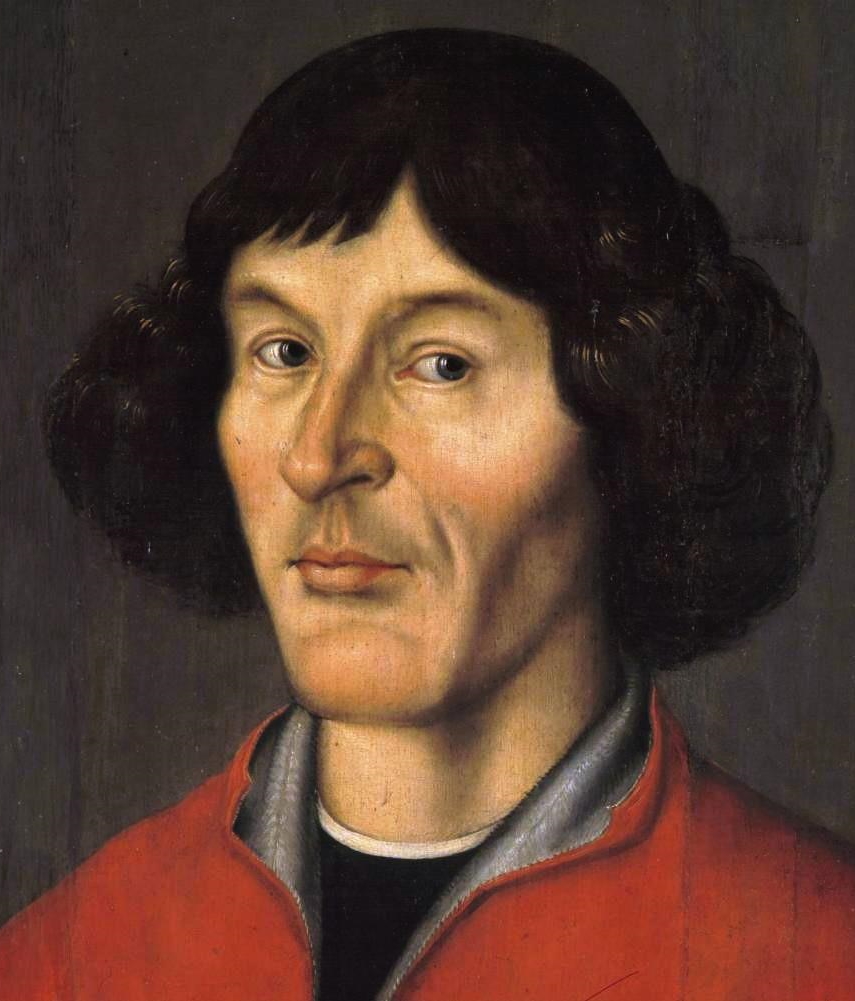 Nicolas Copernicus (1473-1543) Nicolas Copernicus (1473-1543)
In the mid-1500s Copernicus had come up with an alternative
theory: the sun, not the earth, is the center of the universe (he
apparently was not aware that almost 2000 years before him, Aristarchus
had also come up with such a theory).
His purpose – so his publisher states – was not to challenge the
obvious truth of the earth's centrality to the universe – but rather to
make "astrological" calculations (for the purpose of fortune-telling)
less complicated. His heliocentric (sun-centered) theory was
simply to be viewed as a hypothetical system designed to simplify
astrology. He did not intend to posit this theory as a new theory
of Truth or Reality. It was simply a device of convenience. This
anyway is what his publisher wrote in the preface, possibly to protect
Copernicus. Whether Copernicus himself thought that his theories
were or were not matters of mere convenience is much less certain.
Indeed, though his theory seemed to work, it still had many flaws – and
needed a lot of further working out before it might be significantly
better than Ptolemy's theory. As long as the motion of the
planets around the sun was seen to be perfectly circular – rather than
as was later discovered to be elliptical – Copernicus himself would
need theories and formulas and sub-theories and sub-formulas to make
his astrological calculations useful.
In his own days there seemed to be nothing particularly revolutionary
about his theories. They were interesting ... perhaps even
useful. But actually, he had put out in front of the European
mind the suggestion that the sun, not the earth, might be a better
starting point in computing the movements of the heavens. His
ideas were not forgotten.
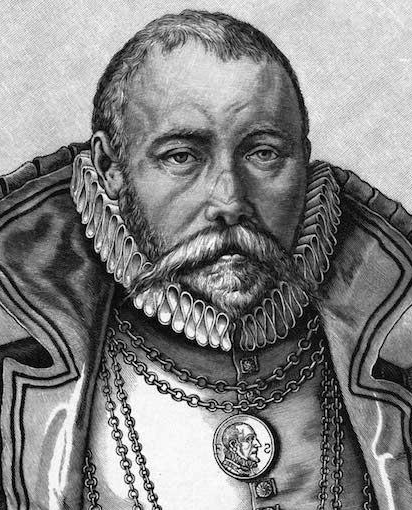 Tycho Brahe (1546-1601) Tycho Brahe (1546-1601)
At the turn of that century (late 1500s/early 1600s) Tycho Brahe made
an enormous contribution to the growing field of inquiry about the
universe and the place of our world in it. He was astrologer and
mathematician for the Holy Roman Emperor. In pursuit of
astrology, he carefully collected observations about the movement of
the heavens. Though these were not intended at the time to serve
the interest of science, they would prove very useful for later
advances in the rising science of astronomy, studying the planets and
stars in order to acquire knowledge of their movements in and of
themselves – quite apart from their "fortune-telling" qualities.
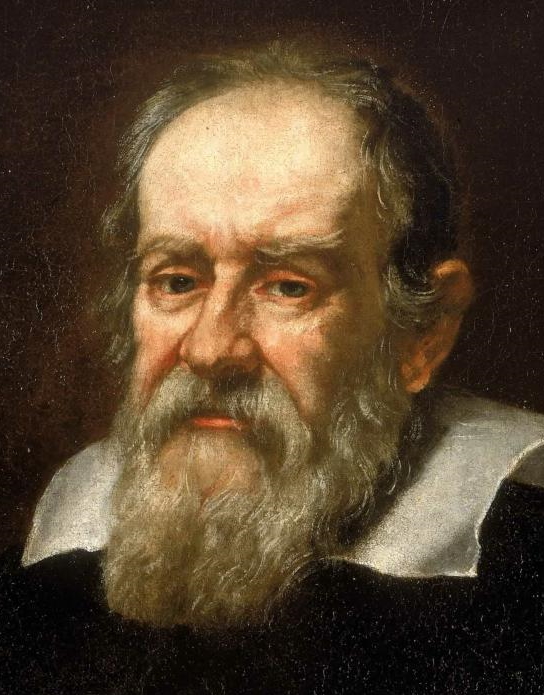 Galileo Galilei (1564-1642) Galileo Galilei (1564-1642)
But still the matter was not given much weight at the time – until in
the early 1600s when it came into the hands of the Italian astronomer
Galileo Galilei. Galileo announced loudly and long that from his
direct observations of the stars, it was clear to him that the
heliocentric theory was not just a conjecture but was in fact the
Truth. Beyond a shadow of doubt, the sun – not the earth – was
the center of things.
His impact did not stop there. Galileo had been armed with a
new-fangled instrument we know as a telescope (even claiming its
invention – though it seems he fudged a bit on this truth). With
this telescope he was able to make many unprecedented observations of
the heavens beyond even the all-important fact of the earth's loss of
central position in the scheme of things. He observed the
pock-marked surface of the moon and the solar flares of the sun –
discounting the ancient Greek religious doctrine that these heavenly
bodies were the epitome of perfection (actual Platonic Ideals or Forms).
He also observed the moons of Jupiter in their regular orbit as
together they all moved about the sun – giving rise to an explanation
of how our moon could be similarly held in orbit around the earth as it
makes its way around the sun.
Also, his telescope revealed considerable mass on the part of some of
the heavenly bodies (the planets) which had appeared to the naked eye
only as points of light in the sky, demonstrating their existence as
substantial material entities: neighbors of the earth. But oddly,
even under the powerful scrutiny of the telescope, other lights in the
heavens (the stars) still remained as only points of light – giving
indication that their distance from our earth must be vastly greater
than had been previously imagined!
At first his announcement was met with much interest from the Italian
Catholic hierarchy ... which initially seemed to be quite supportive of
his studies. But Galileo was a bit of a theatrical
publicity-hound who found that his celebrity status could be greatly
enhanced by clobbering the church with the metaphysical implications of
his discoveries. In case people had not understood the
metaphysical implications of his findings, he was glad to make them
clear. Thus he was loud in his announcement that both tradition
and Scripture – hitherto considered the bedrock of all truth – seemed
to be very wrong on their placement of the earth at the center of the
universal scheme of things. Indeed, he seemed to be eager to
demonstrate every point he could find where his studies challenged
traditional authority.
But this was not a good time to insult the Church and its
truths. Europe was in the midst of the violent
Protestant-Catholic religious wars, and the Protestants were delighting
in another excuse to verbally attack the Catholic Church. As they
picked up on Galileo's threat to the traditional Christian worldview,
they attacked the Pope fiercely for his tolerance of this vile
theory. To the Protestants this was another example of how far
the leadership of the Church was willing to stray from the Truth.
As Protestant criticisms grew sharper, the Pope became increasingly
frustrated by the way Galileo's grandstanding was stirring up even more
controversy within a disintegrating Christendom. Galileo really
didn't need to press this point so much. Also the Church was
getting tired of Galileo's criticisms of its traditional
authority. A show-down between Galileo and the Church thus became
inevitable – given Galileo's personality and the Church's highly
defensive position. Eventually the Pope threatened
excommunication if Galileo persisted. For Galileo, grandstanding
was one thing, excommunication was quite another. So Galileo
yielded. But he also succeeded in letting it be known that,
whatever the Church might force him to say or do, the fact remained
that the sun, not the earth, was the center of things.
However, because he built his sun-centered theory on the notion of
circular paths of the planets around the sun (the paths are in fact
elliptical, not circular) his calculations were flawed – a fact that
many were quick to jump on as proof of the basic falseness of his
theory.
Nonetheless, in this struggle between Galileo and the Medieval
Christian worldview, Galileo struck a hard blow on behalf of
Secularism's view that Christianity was hopelessly lost in ignorance,
and was willing to enforce that ignorance in order to preserve
itself. Galileo was a major contributor to the idea that there
was another truth, another reality than the one put forth by
Christianity.
 For more on Galileo For more on Galileo
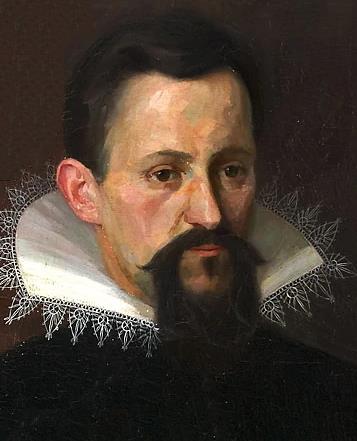 Johannes Kepler (1571-1630) Johannes Kepler (1571-1630)
But very soon after Galileo's grand splash upon the European stage, his
work (also the early 1600s) was backed up by further studies by
Johannes Kepler. Kepler succeeded Brahe as astrologer and
mathematician for the Emperor. As such, he had studied the
heavens in search for a more rationally "beautiful" explanation of the
movement of the heavens.
However, Kepler came at this work from a quite different angle than
Galileo. To Kepler, his work was an almost mystical (Pythagorean)
enterprise. Unlike Galileo, who sought (in the vein of the modern
mindset) to exalt himself as the heroic intellectual explorer, Kepler
sought to glorify God with his work. To him science was there to
validate God – not man.
Kepler employed Brahe's data to refine Copernicus' heliocentric
theory. In an amazing departure from long-held conventional
thinking, he put the circular theory of the movements of the planets
aside. In its place he substituted the amazing theory that the
planets move in elliptical orbits around the sun, in precise and
mathematically simple relations to the sun. In doing so, he
cleared away all the unresolved details of Galileo's (or Copernicus's)
heliocentric theory.
The simplicity and accuracy of Kepler's theory was now too compelling
to be put aside by any religious authority: He was clearly giving
accurate description to a physical reality – and not just a "useful"
theory for making astrological calculations. The Christian world
was going to have to come to terms with Kepler's science. It was
no longer going to suffice simply to point to the authority of
Scripture on the subject. Science was moving into a position of
authority all its own. It was now going to be up to Christianity
to figure out how to handle this newly emerging intellectual authority.
The development of "natural philosophy" (modern science)
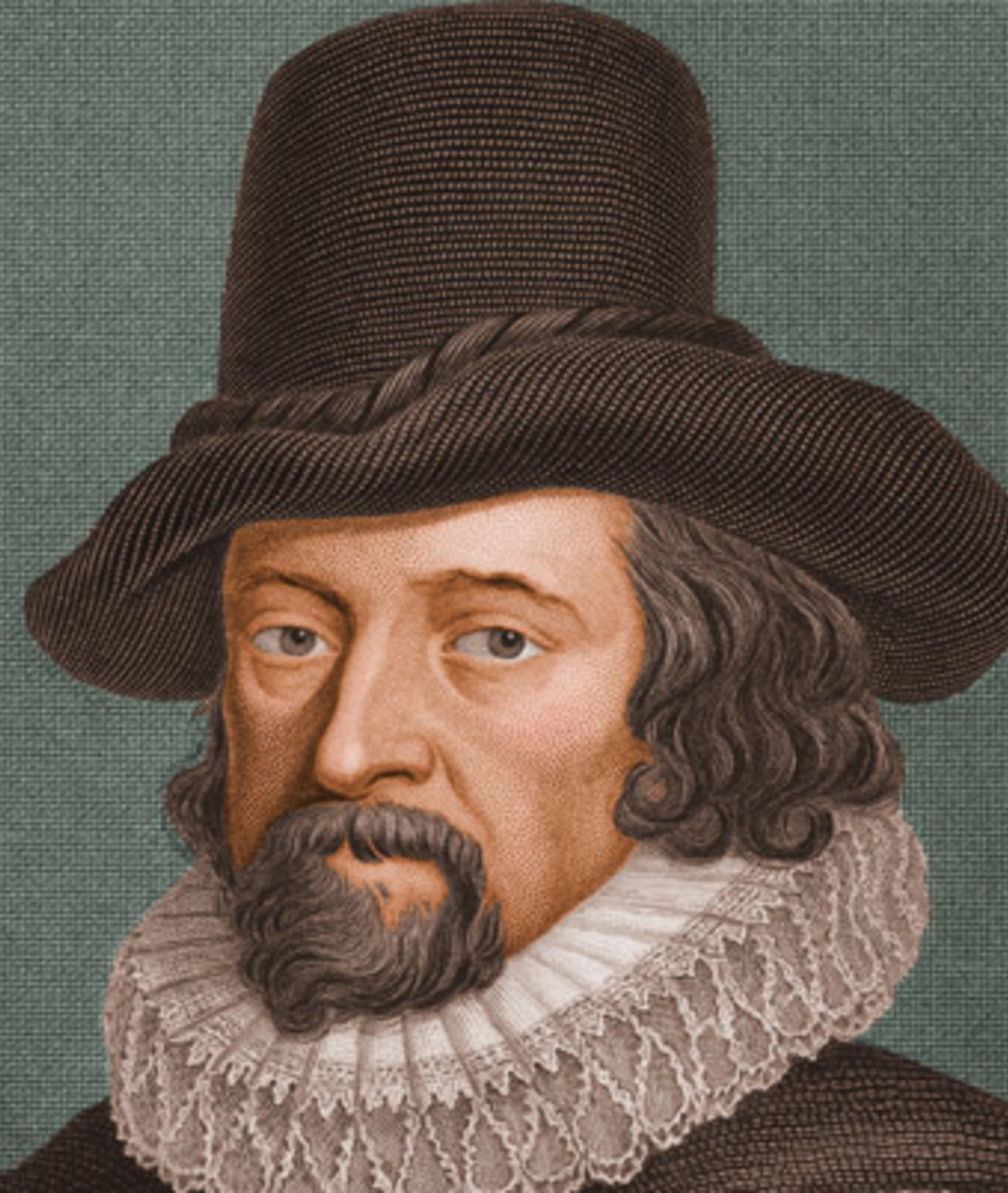 Francis Bacon (1561-1626) Francis Bacon (1561-1626)
In this regard, Bacon is often considered the first expounder of this
new "scientific" method of arriving at Truth – giving the method a
legitimacy as an alternative to religious truth.
Bacon's approach was empirical – collecting bodies of actual
observations or data and then bringing them under the careful study of
a community of scholars. He led scholarship away not only from
the Platonist schools but also the Aristotelian schools that had long
been prevalent in Europe. He, like Aristotle, felt that Truth was
found in direct observation of things and their behavior. But he
was opposed to the quickness by which the human mind likes to jump
"deductively" to develop grand generalities (both Aristotelians and
Platonists). Instead he proposed to work "inductively" from the
hard facts and let them carefully suggest their own theoretical order –
at the same time attacking such theories with doubts and constant
testing, to see at what point they might not hold. In this he was
laying the foundations of empiricism – which would take a strong hold
over the English scholarly mind.
Bacon was a major bridge between the traditional religious worldview
and the newly-arising secularist worldview. He acknowledged the
importance of both, proposing that science and theology were two
separate enterprises because of two different systems of proof required
by each: direct observation and divine revelation. Furthermore,
to Bacon, theology still remained the primary enterprise of the two
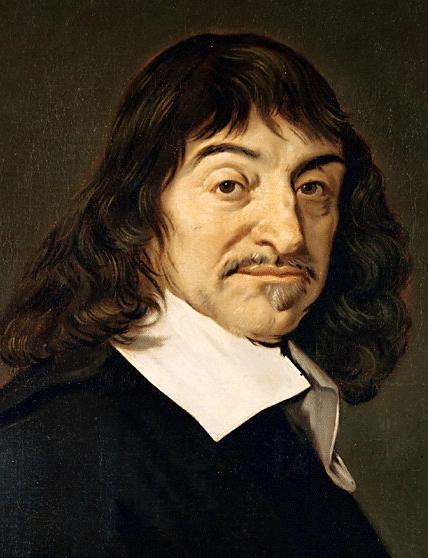 René Descartes (1596-1650) René Descartes (1596-1650)
Taking this idea of Truth being found not from some
ancient or higher religious source – but instead from the principles of
life active all around us – was the French philosopher, René
Descartes. His own understanding of this new approach to Truth
would have a huge impact on Western philosophy.
In some ways Descartes was still a medieval rationalist – who believed
(in keeping with Plato) that all things in the world around us are
merely "extensions" of some variety of mathematical or geometric
abstractions. The underlying truth about our world "out there"
was discoverable really only through careful mathematical meditations
on that world – which could be done at home or in one's closet.
But in any case, what he came up with in his musings was the idea that
the world "out there" was essentially a mechanical device that worked
according to fixed rules of motion. Events occurred as the result
of impacts among the various material bodies that are in constant
motion within this "machine." The machine itself is devoid
of soul or vitality of its own. It simply responds to the "laws" of
motion in a mathematical way.
Impressed by those recent discoveries of Galileo and Kepler concerning
the mathematical formulations that described simply and elegantly the
movements of the heavens (permitting the world to set aside the
horribly cumbersome formulations of the Ptolemaic tradition) Descartes
jumped easily to the belief that all of life was undergirded by such
pure or clear mathematical formulations. Just as pure reason had
discovered those celestial formulas, pure reason would surely also
unlock the formulations for life here on earth.
Believing this to be so, Descartes set about to begin just that task –
to start to lay out the fundamental or foundational truths on which a
mathematical edifice of formulas describing earthly life could
subsequently be built, his Discourse on Method (1637).
This Method was to go to the most fundamental of propositions that
could be demonstrated through logic to be absolutely true – which for
him had to be the reality of his own consciousness, the mind that posed
the question in the first place. It was also a natural starting
point for him, given his underlying faith in the human mind's ability
to embrace the mathematical undergirding of the universe.
The cogito. Thus
his theories all began from the starting point of the "natural
philosopher" (scientist) himself: the famous cogito ergo sum – "I
think, therefore I am." This was the only "certainty" in the
world of ideas, thoughts, or "truths" that lay beyond all doubt.
From that point he moves forward logically in a rather Platonic
manner. Even though he cannot say with any certainty that things
outside him exist – he can be certain that he is having thoughts about
them! Furthermore, these thoughts can easily embrace the idea of
the existence of things in their perfect form – as for instance a
perfect circle. His thoughts also embrace the idea of the
existence of a perfect God. Where do such ideas come from?
He concludes that there has to be something beyond himself, "out
there," something that sets such thoughts into motion. And that
reality out there cannot be less perfect than what his own thoughts can
formulate – for how could he conceive of something as being more
perfect than it actually is? It could not come from his own mind
– for his own mind is itself imperfect, given to doubt. No ...
the Perfect then must exist beyond himself, giving rise to his present
thoughts about such Perfection.
From this he jumps (and it is a jump indeed) that the very Perfection
of God is such that God could not deceive him. Therefore, the
thoughts he was having about a Perfect God had to be true.
[Ingenious, but not very compelling logic!] Further, being God by
nature, God would not allow deceptive thoughts to come among us – that
God would allow only real or true thoughts to come to Descartes' mind
[Descartes does not allow for the existence of a Deceiver – other than
his own flawed doubts].
Probing the Question of Physical Existence or "Physics."
Now he moves in his thoughts (outlined in particular in his 1649 book
Passions of the Soul) to probe more deeply the matter of his own
existence – both body and soul. His body he treats as a physical
extension beyond his conscious mind or soul. But the two, body
and soul (or mind) are closely linked so that they affect each other
directly – supposedly through the pineal gland, located at the base of
the brain!
Nonetheless, it is only the body, as an actual extension, that is
guided by the mathematical laws of physics. The soul, not being
an extension of any kind, does not exist on the basis of these same
laws. It is of a different order of being.
Qualities such as color, sound, smell, temperature, flavor, etc. are
also not extensions themselves but are "secondary" qualities – as
opposed to the primary qualities such as mass and velocity or
movement. Only these primary qualities point to real
existence. Only these primary qualities respond to the laws of
physics – mathematical laws describing the physical machinery called
reality.
Descartes was very unclear in his thinking about how then these secondary qualities actually existed.
Descartes' Contribution to Western Thought.
It was Descartes' thinking on this matter of the surrounding physical
world – its substance, its physical "extension," as the only true base
of existence – that got the Englishman Newton to thinking ...
ultimately to refute Descartes' notions of mass and motion. The
fellow Englishman Locke also would reflect on Descartes' theories – and
adopt some of his thinking about the differences between primary and
secondary qualities of being.
Of course, physics has developed in such a way that many of Descartes'
ideas have been put aside. But overall, he was very persuasive in
his effort to apply rational theories to the existence of physical
matter here on earth. He was very influential in getting natural
philosophers/scientists to begin to probe the nature of material-being
here on earth – as a matter now open to human enquiry.
The purpose was no longer to apply human inquiry to physical life in
order to discover the magical formula for turning base elements into
gold – but to explore physical reality simply for knowledge of such
reality in and of itself.
But some unanswered questions.
However, that left the question of the human soul and will – and the
divine soul and will. Where do we fit in? Are we merely
elements of this mechanical/material world? Is God merely an
element of the mechanical/material world?
To Descartes the answer was clearly a "no" to both questions. But
in affirming our own vitality – and God's – Descartes was forced to
separate the human soul (and God's) from that soul-less
mechanical/material creation "out there." Fine. But how
then were we connected to that world – except as removed
observers? Where was our ancient sense of unity with all
creation? Where in fact did that leave us in relation to God –
and to each other?
Those questions were never adequately answered. The human soul
now seemed to be left cut adrift by what was considered to be a very
compelling philosophical statement – one which swept powerfully through
the philosophical circles of Europe in those days.

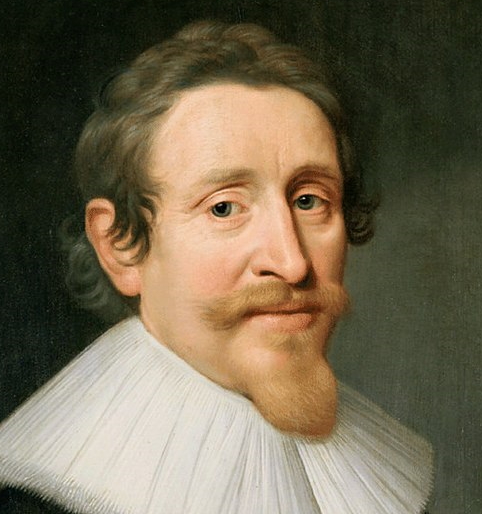
Hugo Grotius (1583-1645)
Another person who made a great contribution to the
development of this new mindset was the Dutchman, Hugo de Groot
(Grotius). In his 1625 work, De jure belli ac pacis (On the Law
of War and Peace), dedicated to the Bourbon King Louis XIII of France,
he appealed to the European conscience to seek a new spirit of openness
or tolerance about matters of Truth, a broad-mindedness about inquiry
concerning Truth.
To further buttress this appeal he set out to try to systematically
collect a listing of rules and legal norms that might in the future
become the underpinning of a new cooperative international order.
He scanned history for laws that had found use in guiding nations
toward peace – and laid them out as a new system of international
law. By basing these laws on proven behavior, he hoped to be
establishing a natural (i.e., scientific) basis for founding peaceful
international behavior. He is thus considered the "Father" of
modern international law.

Thomas Hobbes (1588-1679)
he religious fatigue exhausting the Christian West in
those days also had the effect of developing a political viewpoint that
was both cynical and utilitarian (much in the vein of
Machiavelli). Thomas Hobbes, in his book Leviathan
(1651), called for an all-powerful sovereign who would serve the
interests of the larger political community (i.e., England) by holding
it tightly together under his sovereign authority – in order to curb
the kind of human wantonness experienced in the Wars of Religion.
For Hobbes, such powerful rule was not to be founded on the ancient
rule of the "divine rights" of monarchs – but on the basis of the
needs, even rights, of the community to be served by such an
all-powerful ruler. In justifying this utilitarian approach to
state-building, he used "natural" theory or logic rather than scripture
or tradition, putting forth the first efforts to establish a modern
"political science."
However, his arguments were not greeted warmly by the English monarchy,
which found "divine rights" – rather than society-serving utilitarian
rights as the foundation of its power – much more to its liking!

|

Go on to the next section: Europe during the Second Half of the 1600s
 Miles
H. Hodges; Miles
H. Hodges;
| | | | | |


 Overview
Overview
 The onset of the Dutch "Golden Age"
The onset of the Dutch "Golden Age"
 Some of the other players of the day
Some of the other players of the day
 England of the Stuarts and Puritans
England of the Stuarts and Puritans








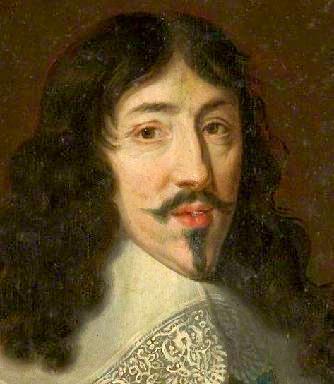
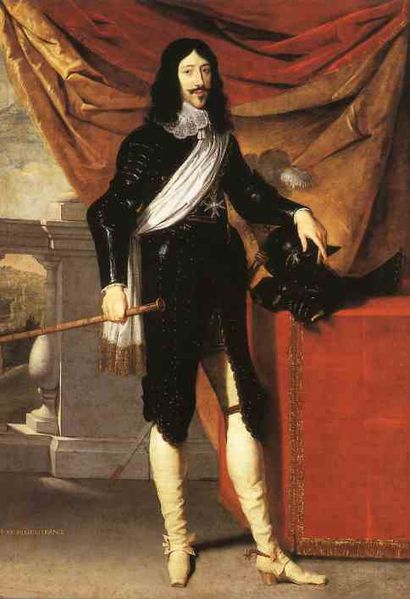
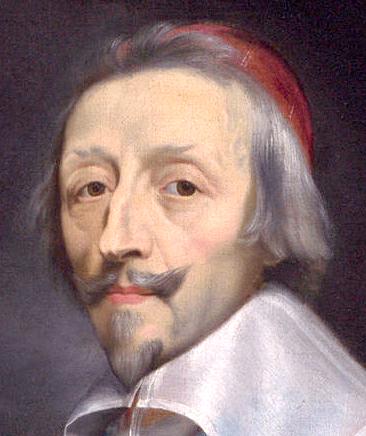
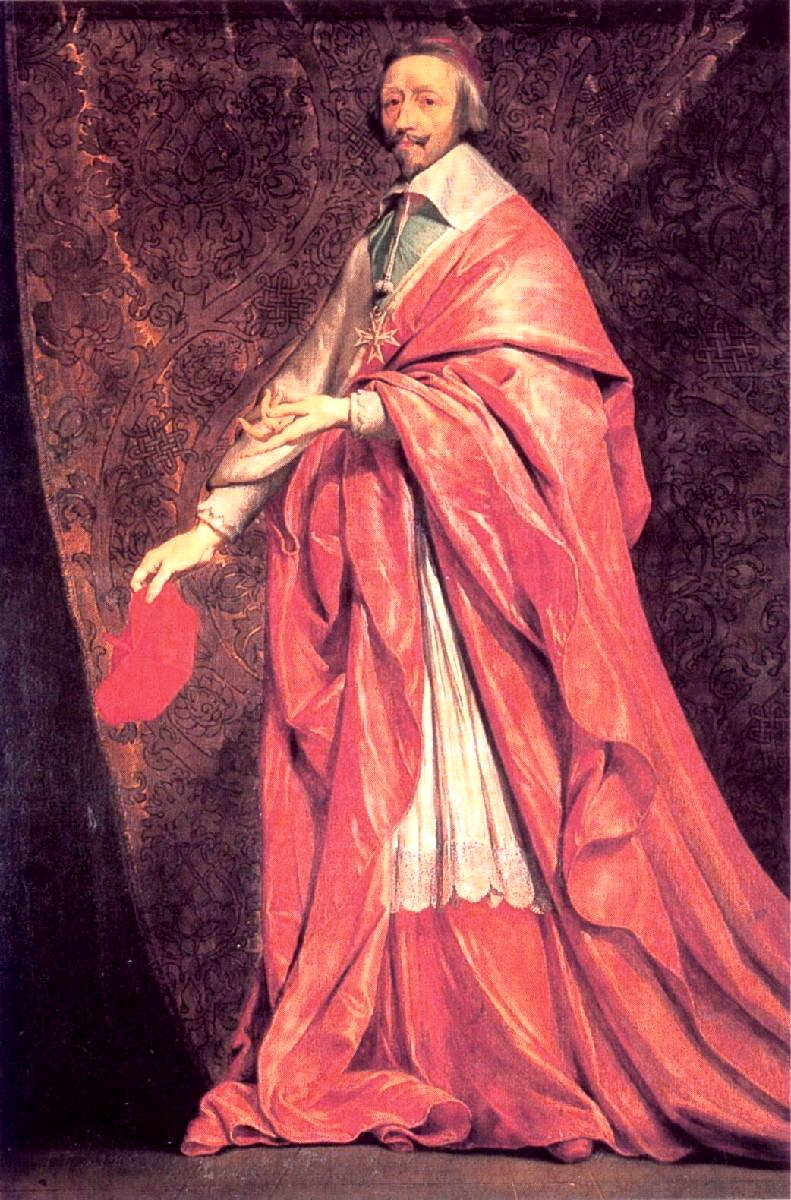






















 However gentlemen did not perform manual labor – which presented a
problem for the Virginia Company, as most of the participants in this
venture were attempting to establish for themselves ratings as
"gentlemen."
However gentlemen did not perform manual labor – which presented a
problem for the Virginia Company, as most of the participants in this
venture were attempting to establish for themselves ratings as
"gentlemen." 




















